New Products
-
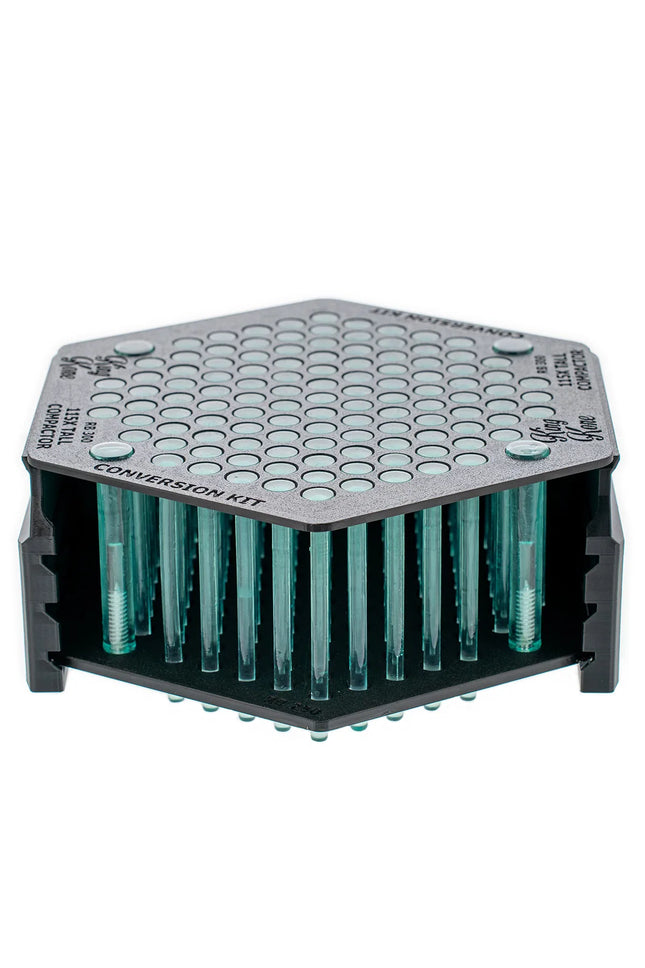

King Kone 115 Extended Tube Packing Fingers - All Tube Sizes
115 Extended Tube Packing Fingers - All Tube Sizes This accessory is an upgraded version of our standard 115 tube packing fingers(typically utilized at the end of the packing process, to pack the end of the product down, in order to close off the tube). The additional advantage of this accessory is the "Height Adjustment Option". It allows for the user to adjust the height of the packing fingers so that it can be used for an additional pack, at any part of the tube packing process. Depending on the product being packed, stickier material may make it more of an obstacle to reach the desired density, especially at the crutch. With these height adjustable packing fingers, an extra pack assisted by the packing fingers, at any length you need, is the easy solution to a perfectly packed pre-rolled tube. Ability to pack: All size straight tubes.
$624.64
-
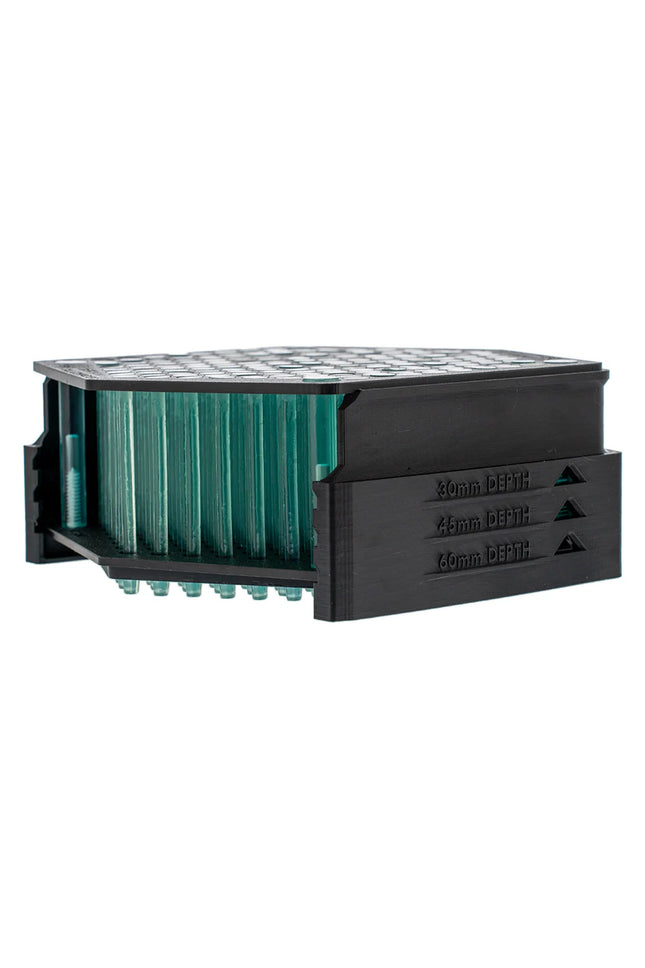

King Kone 169 Extended Cone Packing Fingers
169 Extended Cone Packing Fingers This accessory is an upgraded version of our standard packing fingers(typically utilized at the end of the packing process, to pack the end of the product down, in order to close off the cone). The additional advantage of this accessory is the "Height Adjustment Option". It allows for the user to adjust the height of the packing fingers so that it can be used for an additional pack, at any part of the cone packing process. Depending on the product being packed, stickier material may make it more of an obstacle to reach the desired density, especially at the crutch. With these height adjustable packing fingers, an extra pack assisted by the packing fingers, at any length you need, is the easy solution to a perfectly packed pre-rolled joint. Ability to pack: 84mm, 98mm, 109mm
$624.64
-
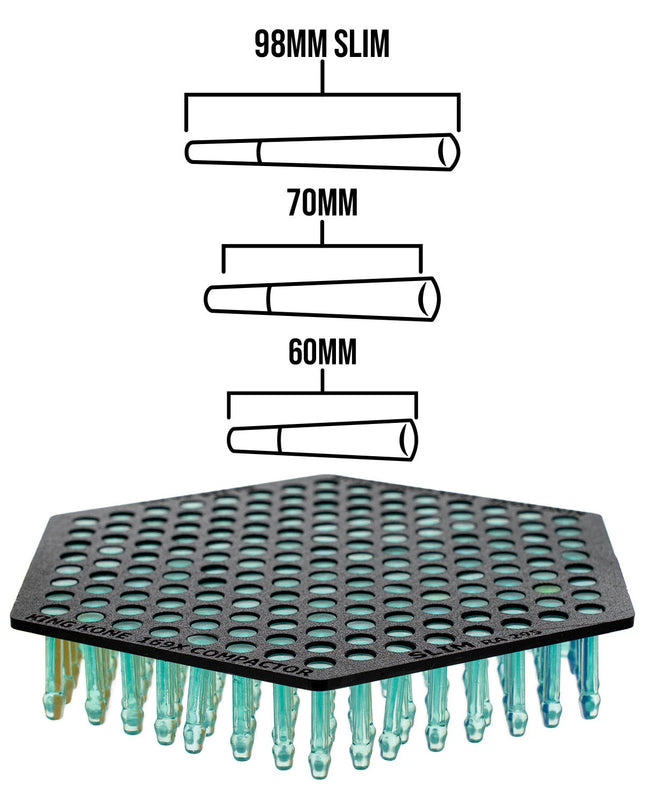
King Kone 169 Slim Cone Packing Fingers - 98mm, 60mm, 70mm
169 Slim Cone Packing Fingers - 98mm, 60mm, 70mm This accessory is utilized at the end of the packing process, to pack the end of the product down, in order to close off the cone. This can help with exposing more paper for the closing process. Ability to pack: 98mm slim, 60mm, 70mm
$520.54
-
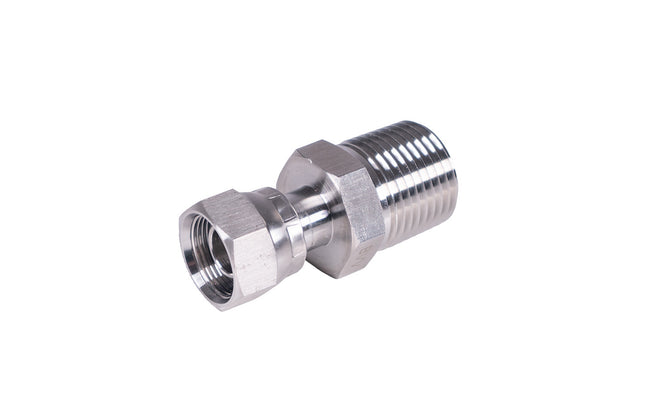
M16x1 F X 1/2" NPT Stainless Steel Adapter (2 pack)
2 pack stainless steel adapter fitting with M16X1 F x 1/2" NPT This adapter will fit on 16mm x 1mm threads found on many heater and chillers made by Julabo or Huber and adapt these threads to 1/2" NPT
$131.87
-


Lidocaine Hydrochloride Powder USP/DMF Grade
Lidocaine ≥97.5% Complies with USP Testing Specifications Lidocaine Hydrochloride is a white crystalline powder widely used as a local anesthetic and antiarrhythmic agent. With rapid onset and intermediate duration of action, it is commonly employed in topical formulations. Its widely used in medical, dental, and veterinary applications. Specifications: Assay: 97.5% – 102.5% Melting Range: 66°C – 69°C Water Content (H₂O): 5.0% – 7.0% Residue After Ignition: ≤ 0.1% Sulfate (SO₄): Passes Test Heavy Metals: ≤ 0.002% This pharmaceutical-grade compound is manufactured under strict quality control standards to ensure consistency, purity, and compliance with international regulatory requirements. Applications: Local anesthesia for minor surgical procedures Pain relief in topical formulations Antiarrhythmic treatment for certain heart conditions Storage: Store in a cool, dry place, protected from light and moisture. Lidocaine Hydrochloride Safety Data Sheet (SDS) Lidocaine Hydrochloride Certificate of Analysis (COA) Chemical Formula: C14H23CIN2O Molecular Weight: 270.80 g/mol CAS Registry Number: 6108-05-0 Appearance White Crystalline Powder Odor: Characteristic Density 0.984 g/mL at 25 °C Boiling Point: 159-160 °C at 2 mmHg Solubility in water: Highly Soluble GHS Pictograms: GHS Signal Word: Danger GHS Hazard Statements: H301, H302 H315, H319, H334, H335, H412 GHS Precautionary Statements P233, P260, P261, P264, P264+P265, P270, P271, P273, P280, P284, P301+P317, P302+P352, P304+P340, P305+P351+P338, P319, P321, P330, P332+P317, P337+P317, P342+P316, P362+P364, P403, P403+P233, P405, P501 UN Identification Number: None Proper Shipping Name: None Transport Hazard Class: None Packing Group: None DOT Placard: None
$19.43 - $902.26
-


Oxone PS-16 Monopersulfate (Non-Chlorine Shock)
OxoneTM PS-16 Monopersulfate | Non-Chlorine Shock Oxone PS-16 Compound is used as an active ingredient in disinfectant formulations (not registered as a biocide in USA), and as an oxidizing agent in other formulations, such as pool & spa non-chlorine shock oxidizers, denture cleansers and laundry bleaches. The grade is also used as a wet strength resin paper repulping aid, metal surface treatment agent, selective oxidizer in chemical synthesis, wool shrink-proofing treatment, waste water treatment and odor control agent. Applications: Water Treatment: It can be used to treat water, including drinking water and pool & spa water, due to its ability to kill bacteria and neutralize contaminants. Cleaning and Sanitization: It's used in various industrial cleaning products, especially for disinfecting surfaces or purifying air and water. Oxidation Reactions: In chemical processes, Oxone PS-16 can be used as a strong oxidizing agent to break down pollutants or aid in chemical synthesis. Active Ingredients: Potassium Peroxymonosulfate (KHSO₅) - 45% Other Ingredients - 55% Total -100% Bag Dimensions: 21"x14"x4" (55.1lbs) Chemical Formula: KHSO₅·KHSO₄·K₂SO₄ Molecular Weight: 614.8 g/mol CAS Registry Number: 70693-62-8, 7646-93-7, 7727-21-1 Appearance White Granules Odor: Odorless Density 2.35 g/cm3 (68 °F / 20 °C) Boiling Point: None Solubility in water: Highly and Readily Soluble at 297–357 g/L at 22°C (72°F) GHS Pictograms: GHS Signal Word: Danger GHS Hazard Statements: H302, H314 GHS Precautionary Statements P260, P264, P270, P280, P301 + P312 + P330, P301 + P330 + P331, P303 + P361 + P353, P304 + P340 + P310, P305 + P351 + P338 + P310, P363, P405, P501 UN Identification Number: 3260 Proper Shipping Name: Corrosive solid, acidic, inorganic, n.o.s. (Monopersulfate Compound) Transport Hazard Class: 8 Packing Group: II DOT Placard: Oxone PS-16 Monopersulfate (SDS) Oxone PS-16 Monopersulfate Certificate of Analysis (COA)
$11.10 - $383.11
-
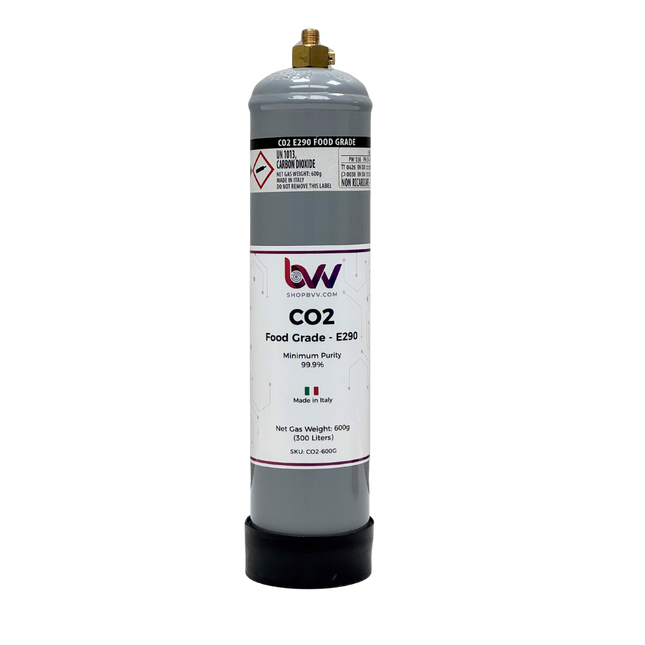

CO2 Tank Filled, 600g E290 Food Grade
CO2 Tank 600g Food Grade E290 - Liquid CO2 Filled Made in Italy Our CO2 tank arrives filled with 600g of compressed liquid CO2. The gas can be removed using our regulator or valve dispenser that attaches to the top of the tank. Tank Thread: M11 x 1.0 Regulator Thread: M11 x 1.0 (Connects to tank) Regulator Output: 1/4" Brass Barb Valve Dispenser Output: 1/4" Brass Barb Valve Dispenser Thread: M11 x 1.0 (Connects to tank) *Tank is non-refillable *At end of use, completely empty the tank for recycling. *Note CO2 Tank Pressure is 855PSI Tank Volume of Helium Product Sku: 600g / 326.8 Liters / 86.3 Gallons CO2-600G Regulator/Dispenser Details (not included with tank only purchase) Regulator - Adjustable via. needle valve, regulated to 80 PSI. Made in Italy. Thread: M11x1 (tank connection). Output: 1/4" Barb to connect to any hose with a 1/4" I.D. (inside diameter) Gauges read in BAR. M11 Valve Dispenser Kit - Includes adjustable pushpin style valve dispenser. Output: 1/4" Brass Barb, NO GAUGES Chemical Formula: CO2 Molecular Weight: 44.009 g/mol CAS Registry Number: 124-38-9 Appearance Colorless Odor: Odorless Density 0.114 lb/ft3 (178.6 g/m3) Boiling Point: N/A Solubility in water: Completely Soluble GHS Pictograms: GHS Signal Word: Warning GHS Hazard Statements: H280, H281 GHS Precautionary Statements P282, P336+P317, P403, and P410+P403 UN Identification Number: 1013 Proper Shipping Name: Carbon Dioxide Transport Hazard Class: 2.2 Packing Group: None DOT Placard: Carbon Dioxide Safety Data Sheet (SDS)
$36.09 - $145.75
-


Acetonitrile High Purity
Acetonitrile (CH₃CN) is a colorless, volatile, and flammable liquid organic compound with a distinctive, slightly sweet odor. It is the simplest aliphatic nitrile and is commonly used as a solvent in laboratories and industries due to its ability to dissolve a wide range of polar and nonpolar substances. Acetonitrile is highly polar, miscible with water and many organic solvents, and is often used in the production of pharmaceuticals, plastics, and adhesives. Additionally, it plays a key role in the extraction and purification of various compounds, especially in high-performance liquid chromatography (HPLC). Acetonitrile is widely used in various industrial, laboratory, and scientific applications. Some of the key applications of acetonitrile include: Solvent in Organic Synthesis: Acetonitrile is often used as a solvent in organic synthesis due to its ability to dissolve a wide range of both polar and nonpolar substances. It's commonly employed in reactions involving electrophilic substitution, nucleophilic substitution, and polymerization. High-Performance Liquid Chromatography (HPLC): Acetonitrile is a common solvent in HPLC, where it's used in mobile phases for separating and analyzing compounds, particularly in the pharmaceutical and environmental industries. Pharmaceutical Industry: Acetonitrile is used in the production of various pharmaceuticals, particularly in the synthesis of intermediates and active pharmaceutical ingredients (APIs). It helps to purify and isolate compounds in medical formulations. Extraction and Purification: Acetonitrile is used in liquid-liquid extraction to separate or purify chemicals, such as when isolating nucleic acids or proteins, and in the extraction of rare earth metals. Chemical Manufacturing: It is involved in the production of acetic acid, adiponitrile (for nylon production), and various other chemicals, such as dyes, resins, and plastics. Electrochemical Applications: Acetonitrile is used in electrochemical processes due to its high polarity and low viscosity, making it suitable for applications like electroplating and electrochemical cell research. Cleaning and Degreasing: In some industrial applications, acetonitrile serves as a cleaning agent, helping to remove grease, oils, and other contaminants from machinery and equipment. Gas Chromatography (GC): It can be used as a solvent in GC to help in the analysis and separation of volatile organic compounds. Chemical Formula: C2H3N + CH3CN Molecular Weight: 41.05 g/mol CAS Registry Number: 75-05-8 Appearance Colorless Liquid Odor: Sweet, ethereal Density 0.787 at 68 °F (less dense than water) Boiling Point: 82°C /179 °F Solubility in water: 800 g/L at 25 °C GHS Pictograms: GHS Signal Word: Danger GHS Hazard Statements: H225, H302, H312, H332, H319 GHS Precautionary Statements P210, P233, P240, P241, P243, P261, P264, P270, P271, P280, P301, P212, P330, P303, P361, P353, P304, P340, P312, P305, P351, P338, P337, P313, P363, P370,P378, P403, P235, P501 UN Identification Number: 1648 Proper Shipping Name: Acetonitrile Transport Hazard Class: 3 Packing Group: II DOT Placard: Acetonitrile Certificate of Analysis (COA) Acetonitrile Safety Data Sheet (SDS)
$20.82 - $1,110.47
-


Deionized Water (DI) - Ultrapure Water - Type 1
Deionized Water Ultrapure Water - Type 1 Deionized Water Type 1, also known as ultrapure water, is water that has been processed through ion-exchange methods to remove nearly all of its dissolved ions, such as minerals, salts, and other charged particles. This ultra-purification process results in water with a very low level of conductivity, making it ideal for high-precision applications in laboratories, pharmaceuticals, electronics manufacturing, and scientific research. As defined by the ASTM there are only 4 types of Pure Water. Type 1 being the most pure. Type 1 deionized water is the highest grade of deionized water, ensuring a high level of purity, typically with resistivity values of 18.2 MΩ·cm at 25°C. It is free from contaminants like bacteria, organic material, and particulate matter, making it suitable for critical tasks like reagent preparation, tissue culture, analytical procedures, and cleaning of sensitive equipment. Due to its lack of ions and impurities, Deionized Water Type 1 is non-reactive, ensuring it does not interfere with experiments or sensitive processes, which is essential in fields requiring the highest level of water purity. *Packaged in FDA Compliant HDPE Bottles. Each order is poured directly from the factory drum ensuring you get the freshest stock upon delivery. Deoinized Water Certificate of Analysis COA Deionized Water Safety Data Sheet SDS
$13.88 - $583.00
-


Vinegar 50% Technical Grade Industrial Stregnth
Technical Grade Vinegar 50% Made in USA - Industrial Strength *The strength of this vinegar requires Hazmat Shipping Fees* The acidic nature of nontoxic vinegar is so powerful it dissolves mineral deposits, dirt, grease, grime from glass, tile, laminate, and stainless-steel surfaces. It deodorizes, and degreases surfaces in kitchens, laundry rooms, and bathrooms. This lab grade product delivers greater cleaning and descaling performance for industrial applications. Higher concentrations of acetic acid (Vinegar) like this can impair the cell membrane of bacteria and fungi, making this a great choice for disinfection. ***Recommended dilution varies by application. Chemical Formula: CH3COOH Molecular Weight: 60.05 g/mol CAS Registry Number: 64-19-7 Appearance Colorless Odor: Vinegar Density 1.061 - 1.075 g/cm3 Boiling Point: 100 °C (212 °F) Solubility in water: Completely Soluble GHS Pictograms: GHS Signal Word: Danger GHS Hazard Statements: H314 GHS Precautionary Statements P210, P233, P240, P241, P242, P243, P260, P264, P280, P301+P330+P331, P302+P361+P354, P303+P361+P353, P304+P340, P305+P354+P338, P316, P321, P363, P370+P378, P403+P235, P405, and P501 UN Identification Number: 2970 Proper Shipping Name: Acetic Acid Solution Transport Hazard Class: 8 Packing Group: II DOT Placard: Vinegar 50% Certificate of Analysis (COA) Vinegar 50% Safety Data Sheet (SDS)
$18.05 - $3,678.45
-


Xylene Technical Grade
Xylene Technical Grade Xylene is a versatile, colorless liquid with a sweet odor, commonly used as a high-performance solvent in various industrial applications. It is a mixture of three isomers—ortho-xylene, meta-xylene, and para-xylene—and is widely recognized for its ability to dissolve oils, resins, and other complex substances. Xylene is commonly used in industries such as coatings, paints, printing, and adhesives, due to its excellent solvency power and ability to improve the quality and consistency of products. Xylene is a vital component in industrial and laboratory settings, ensuring smooth operations and efficient production. While it offers excellent performance in various applications, it should be handled with care due to its flammable nature and potential health risks when inhaled or ingested. Key Features: High solvency power Ideal for use in paints, coatings, adhesives, and varnishes Effective cleaning and degreasing agent Key ingredient in chemical manufacturing Suitable for industrial and laboratory applications Applications: Paints and coatings Printing inks Chemical manufacturing Adhesives and sealants Industrial cleaning Laboratory use Note: Xylene should be stored in a cool, well-ventilated area away from open flames, and proper safety precautions should be followed during use. Chemical Formula: (CH3)2C6H4 Molecular Weight: 106.17 CAS Registry Number: 106-42-3 Appearance Transparent Colorless Odor: Sweet Pungent Aromatic Hydrocarbon Density 7 .25 lbs/gal0.87 g/ml Boiling Point: 276.04 °F (135.58 °C) Solubility in water: Not Soluble GHS Pictograms: GHS Signal Word: Warning GHS Hazard Statements: H226, H312, H315, H332 GHS Precautionary Statements P210, P233, P240, P241, P242, P243, P261, P264, P271, P280, P302+P352, P303+P361+P353, P304+P340, P317, P321, P332+P317, P362+P364, P370+P378, P403+P235, and P501 UN Identification Number: 1307 Proper Shipping Name: Xylenes Transport Hazard Class: 3 Packing Group: III DOT Placard: Xylene Certificate of Analysis (COA) Xylene Safety Data Sheet (SDS)
$20.82 - $728.75
-
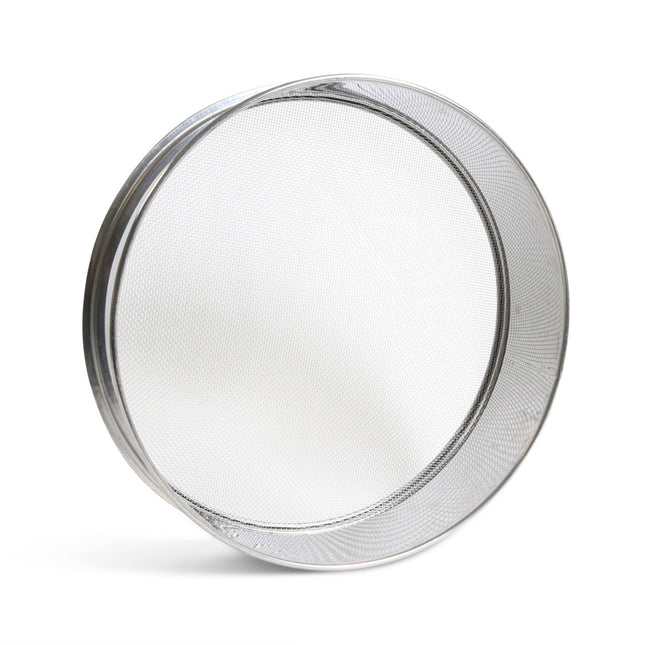

AVS-16.75X6 Screen (No Housing) (Compare to Custom Cones)
AVS-16.75X6 Screen (No Housing) Description Please note that this screen is for use with Automtic Vibrating Sifter - Industrial 16.25 x 6" Machines ONLY. It is not compatible with the Automatic Vibrating Sifter - Commercial 15.50 x 4". Specifications: COMPATIBLE WITH: Automtic Vibrating Sifter - Industrial 16.25 x 6" (This is not compatible with the Automatic Vibrating Sifter - Commercial 15.50 x 4".) SCREEN DIAMETER: 16.75 Inches SCREEN DEPTH: 6 Inches HOLE SHAPE: Square
$111.05
-
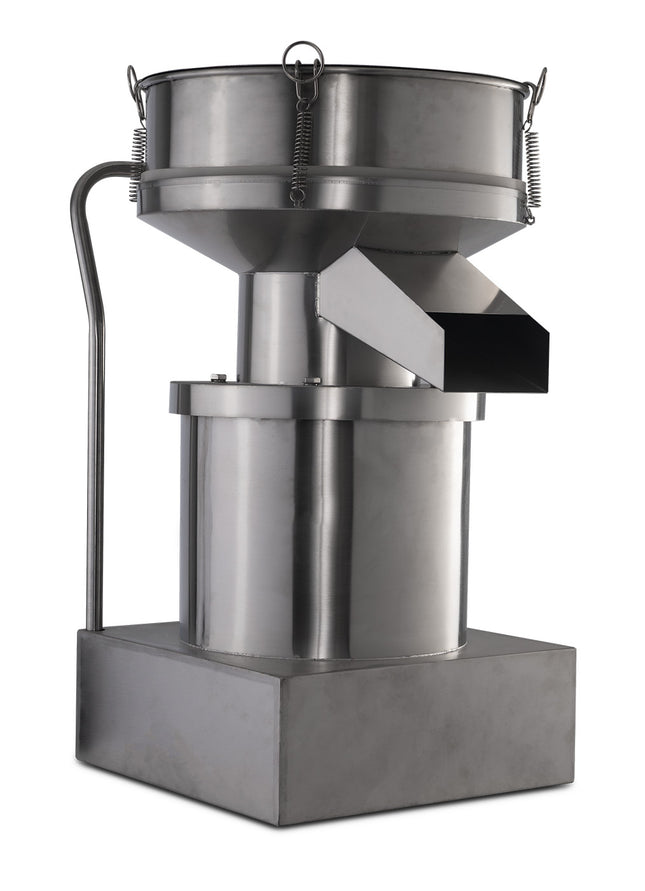
Industrial Vibrating Sifter - 16.25 x 6" (Compare to Custom Cones)
Automatic Vibrating Sifter - Industrial 16.25 x 6" This item Ships Freight - 88 lbs. Sifting your plant material is a great way to remove stems automatically, and if you are producing a premium pre-roll product, it is always best to sift out any stems! Our Large Automatic Vibrating Sifter was explicitly designed with plant processors in mind - the stainless steel construction and screens ensure you can easily clean our sifter, and the screen sizes are fine-tuned for the most common sifting needs. Once you've ground your plant material, you only need to pour your flower into the sifter and switch it on. You can now walk away and wait for your flower to be automatically sifted - no more standing around doing manual sifting. Sifting your plant material will not only ensure no stems make it into your pre-rolls but will also ensure nothing else makes it into your pre-rolls, like large leaves, gravel, or any other foreign matter. The consistent grind will make your pre-rolls burn more evenly and pack more evenly in any cone-filling machine. Package Dimensions - 19"x21"x35"
$2,082.14
-
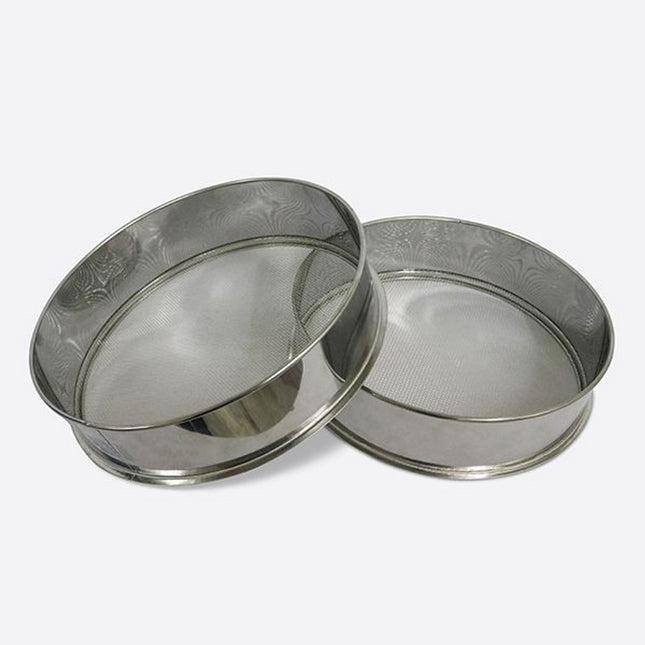
AVS-15.50X4 Screen With Housing (Compare to Custom Cones)
AVS-15.50X4 Screen With Housing Description Please note that this screen is for use with Commercial and industrial Sifting Machines ONLY. It is not compatible with the Automatic Vibrating Sifter - Mini 11.75 x 4". Specifications: COMPATIBLE WITH: Automatic Vibrating Sifter - Commercial 15.50 x 4" (This is not compatible with the Automatic Vibrating Sifter - Mini 11.75 x 4".) SCREEN DIAMETER: 15.50 Inches SCREEN DEPTH: 4 Inches HOLE SHAPE: Square
$111.05
-
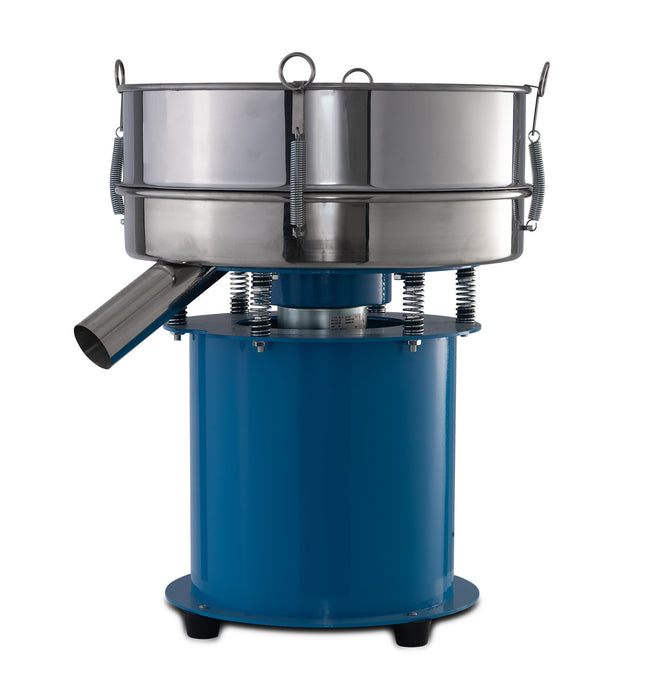
Commercial Vibrating Sifter - 15.50 x 4" (Compare to Custom Cones)
Automatic Vibrating Sifter - Commercial 15.50 x 4" Sifting your plant material is an excellent way to remove stems automatically. This commercial sifting machine was explicitly designed with processors in mind - the stainless steel construction and screens ensure you can easily clean our sifter, and the screen sizes are fine-tuned for the most common sifting needs. The commercial grade sifter offers a larger diameter, coming in at 15.50 inches, compared to the 11.75 inches of the original starter sifter - this means you'll be able to sift more plants in one sitting! Once you've ground your plant material, you only need to pour it into the sifter and switch it on. You can now walk away and wait for your plants to be automatically sifted - no more standing around doing manual sifting. Sifting your biomass will not only ensure no stems make it into your final product but will also ensure nothing else makes it into your product, like large leaves, gravel, or any other foreign matter. Additionally, consistent grinding will make your product burn more evenly and pack more evenly in any cone-filling machine. Plant Material Specific Sifter The commercial sifter was explicitly designed for plant material processors. From its stainless steel construction to multiple screen sizes, our team of Experts is confident this sifter or our other larger sizes will be the perfect addition to your product production process. We offer multiple screen sizes, allowing you to customize the particle size for the plant material in your product. Depending on the strain or weight of the product you are making, you may want to experiment with various screen sizes. Multiple Screen Sizes When it comes to sifting your plant material, you will want to have an ideal particle size for your plant material in mind. If you are still determining what size screen you need, our team of Experts is here to help! Depending on your strain and grinder, your ground biomass will have a different consistency. Additionally, depending on the size of the cone you are using and your desired fill weight, the particle size of your plant material will play a significant role. For example, a smaller particle size will allow you to pack more plant material into a small cone, but a particle size that is too small may lead to a poor, uneven burn. Specifications PURPOSE: Sifting Ground plant materialCONSTRUCTION: Stainless SteelSCREEN DIAMETER: 15.50 inchesMACHINE TYPE: SifterPOWER REQUIREMENT: 120vRATED VOLTAGE: 110VRATED FREQUENCY: 60HzRATED POWER: 50W
$1,388.09
-
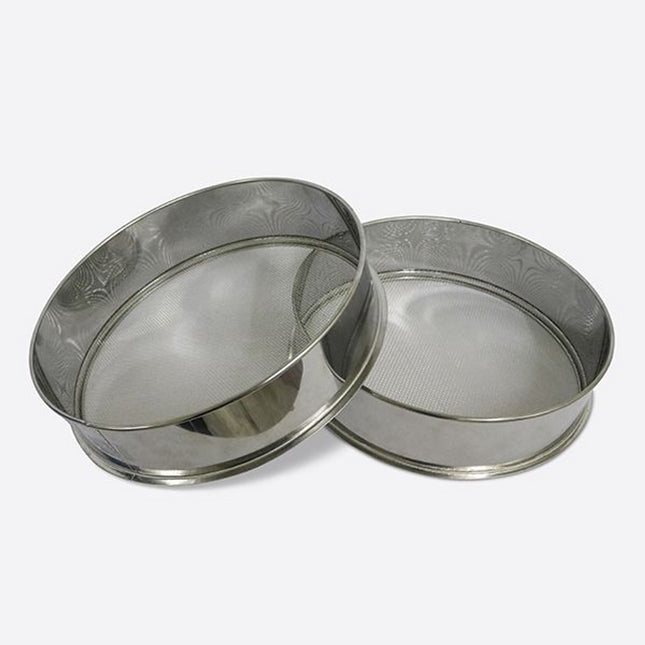
AVS-11.75X4 Screen With Housing (Compare to Custom Cones)
AVS-11.75X4 Screen With Housing Description Please note that this screen is for use with the Automatic Vibrating Sifter - Mini 11.75 x 4" ONLY. It is not compatible with the larger Commercial and industrial Sifting Machines. Specifications COMPATIBLE WITH:: Automatic Vibrating Sifter - Mini 11.75 x 4"(Not compatible with larger sifters) SCREEN DIAMETER: 11.75 Inches SCREEN DEPTH: 4 Inches HOLE SHAPE: Square
$69.40
-
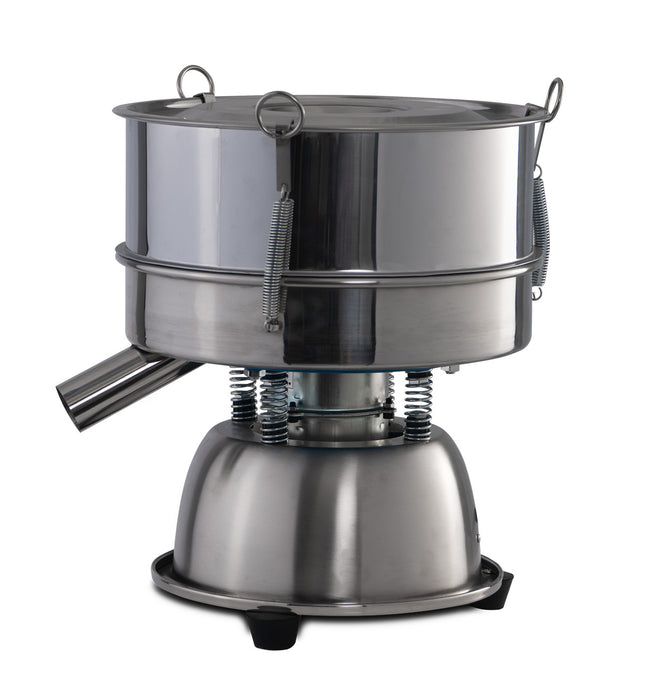
Mini Vibrating Sifter - 11.75 x 4" (Compare to Custom Cones)
Automatic Vibrating Sifter - Mini 11.75 x 4" Sifting your plant material is a great way to remove stems automatically, and if you are producing a premium product, it is always best to sift out any stems! Our Automatic Vibrating Sifter- Mini 11.75 x 4" was explicitly designed with plant material processors in mind - the stainless steel construction and screens ensure you can easily clean our sifter and the screen sizes are fine tuned for the most common sifting needs. Once you've ground your plant material, you only need to pour it into the sifter and switch it on. You can now walk away and wait for your plant material to be automatically sifted - no more standing around doing manual sifting. Sifting your plant material properly will not only ensure no stems make it into your product but will also ensure nothing else makes it into your products, like large leaves, gravel, or any other foreign matter. The Consistent grind will make your products burn more evenly and pack more evenly in any cone-filling machine. Plant Material Specific Sifter Our Automatic Vibrating Sifter- Mini 11.75 x 4" was explicitly designed for plant material processors. From its stainless steel construction to multiple screen sizes, our team of Experts is confident this sifter or our other larger sizes will be the perfect addition to your product production process. We offer multiple screen sizes, allowing you to customize the particle size for the plant material in your product. Depending on the strain or weight of the product you are making, you may want to experiment with various screen sizes. Multiple Screen Sizes When it comes to sifting your plant material, you will want to have an ideal particle size for your plant material in mind. If you are still determining what size screen you need, our team of Experts is here to help! Depending on your strain and grinder, your ground plant material will have a different consistency. Additionally, depending on the size of the cone you are using and your desired fill weight, the particle size of your plant material will play a significant role. For example, a smaller particle size will allow you to pack more plant material into a small cone, but a particle size that is too small may lead to a poor, uneven burn.
$763.45
-
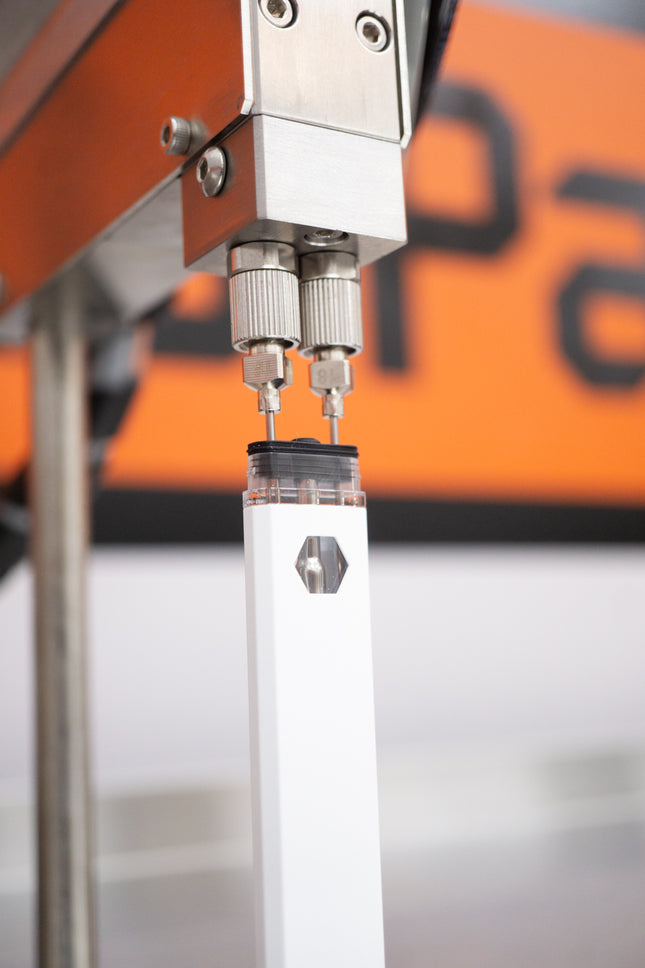

CNC Packaging CNC Packaging C- Solo Cartridge Filling Machine
C- Solo Cartridge Filling Machine C-SOLO KEY FEATURES: Hands Free Foot Pedal Operation Fills up to 2200 units per hour Fills pods, disposables, carts, and luer lock syringes Internally Integrated Heating System Fill Volume from 0.1mL to 1.1mL *available in 3ml upon request* Low Maintenance Design Designed and Manufactured in the USA C-SOLO SPECIFICATIONS: 0.1-1.1mL Filling Volume OR 0.3-3.1mL Filling Volume Filling Accuracy +/- 0.02mL 500mL Capacity 2 zone PID Temperature Control Vessel Temperature from 10° to 75° C Syringe Temperature from 10° to 90° C 0-30psi System Purge Up to 750 psi Injection Pressure REQUIREMENTS: 120vAC 3A Single Phase Filtered, Dry and Oil Free Compressed Air, 80psi 20x20x24” Table Area (LxWxH) Plus Foot pedal Operation Manual
$13,186.89 - $14,574.98
-
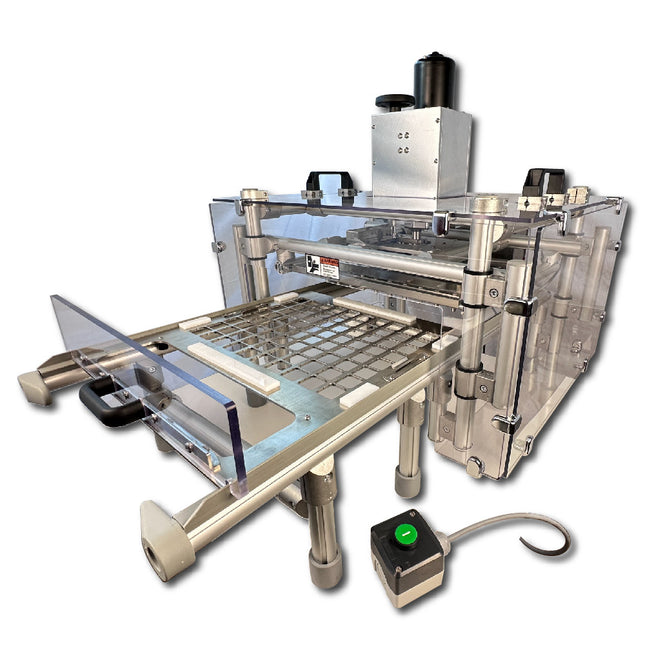

Truffly Made Truffly Made - Automatic Candy Demolder
Automatic Candy Demolder Fully Electric! Plug & Play Anywhere – No Compressed Air Required The Automatic Candy Demolder is designed to remove a full sheet of candies from molds in one “pop”. Unmold your trays in second! Ideal for Hard Candy, Gummies, Caramels, Chocolate, Caramel, Taffy and more! The automatic mold “Popper” includes one standard mold frame to match the Truffly Made mold you are using. Please note that molds are not included. Custom mold plates are available for additional 1,699 USD to work with your silicone molds* Unmolding Rate: 15,000+ pieces per hour Adjustable Speed Dimensions: 27.16” W x 38.58” L x 27.56” H *The Automatic Candy Demolder is compatible with most Truffly Made molds and Non-Truffly Made molds as long as the cavities can be popped inside-out completely and minimum 8mm spacing between each cavities. Maximum cavities per mold = 80 Maximum Mold size = 11.5 x 15” Please contact info@trufflymade.com for a custom quote LARGE PIN FITTINGS AVAILABLE HERE ☜ Please select the type of mold you are using from the list, All Truffly Made molds listed are compatible with the demolder. For any silicone mold not listed, or is from a different manufacturer, please contact us before placing an order to verify compatibility. The Truffly Made Automatic Demolder. Easy to use, just one press to pop out a full mold sheet of candies within seconds!. Works best if the candies are cooled off and hardened. Select the mold frame that matches the mold you are using. Place the mold frame in to the Demolder. Add your filled mold on top of frame. Slide the frame in the Demolder Press the pedal. DONE! All your candies are unmolded. PLEASE NOTE THAT THE UNMOLDING EFFICIENCY IS VARIABLE DEPENDING ON PRODUCT STICKINESS. . WE RECOMMAND TO UNMOLD WITHIN 3 HOURS AFTER DEPOSITNG FOR BETTER EFFICIENCY. . SILICONE MOLDS CAN BE PRE-COATED USING MCT OIL , MINERAL OIL OR COOKING SPRAY TO INCREASE UNMOLDING EFFICIENCY. . Specifications: Height: 700mm / 27.56” Width: 690mm / 27.16” Length: 980mm / 38.58” Weight: approx. 32 kg / 70 lbs with pusher and frame Material: Stainless Steel / Aluminum Power input: 100-240V AC / 50-60Hz Power Output: 24V DC / max.320W Electric motor: 7 amps, force: 10Nm, speed infinitely adjustable up to 70rpm; Change of direction of rotation Treble-bass adjustment; Penetration depth setting: 15mm Foot or Hand Pedal Activated Made in Germany
$15,685.46 - $18,242.33
-
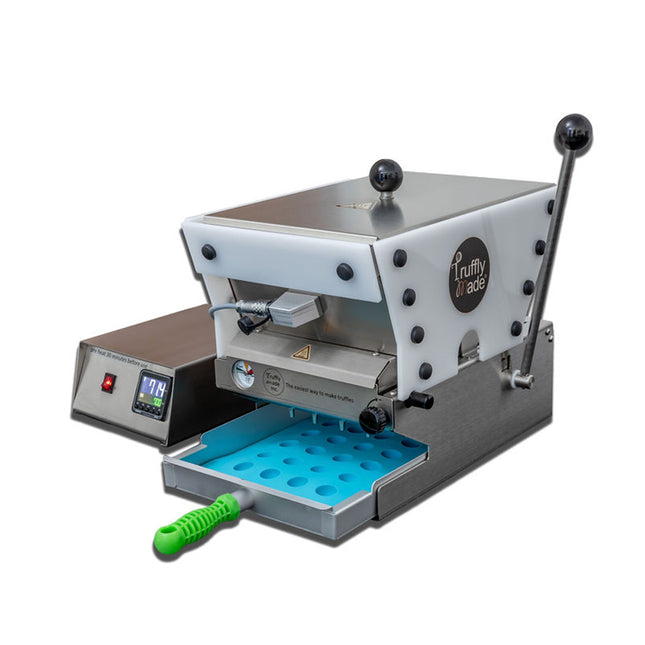

Truffly Made Truffly Made - Compact Universal Depositor
Compact Universal Depositor This Compact Universal Depositor comes with a digital control unit to regulate the temperature from 70F to 300F, 4 adjustable nozzles and a 3 liters / 3.15 quart hopper. It has been designed to work with most of the standard molds on the market, including silicone and polycarbonate products. Use your existing molds or simply adjust molds to fit. Maximum mold size that can fit is 6.5 x 15 inches. Ideal for Gelatin and Pectin gummy. Certified to work with LorAnn Oils Gummy MixCertified to work with Melt To Make™Certified to work with Candy Pros The Compact Universal Depositor delivers accurately metered fillings to the gram with great flexibility.Stainless steel construction with POM case. Four adjustable depositing nozzles, which can be easily positioned or removed to work with any mold layout. Compact Tabletop Confectionery Depositor 3 Liters The Truffly Made Compact Universal Depositor is designed to remove the burden of filling multiple cavity candy molds while increasing the accuracy and uniformity of filling each mold. The Compact Universal Depositor heats for chocolate, gummies and candy Easily adjustable shot size to the exact gram. 3 Liters / 3.15 qt. Hopper Size The four nozzles have adjustable centerlines to accommodate various mold configuration. Nozzles are removable to accommodate molds with less cavities. The heated pistons and hopper maintain temperature and flow. Bottom Hopper heated through pistons while lever bar is down. Front Hopper heated through a heating panel Hygienic stainless steel construction, metal nozzles, POM case. Adjustable temperature digital control panel. The Depositor can work with molds up to 6.5 inches wide. Made in Germany. The complete machine may be disassembled without tools for easy cleaning. Specifications Width: 9.75” Length: 16.5” Height: 11.5” Weight: 23 lbs Hopper Capacity: 3.15 quarts/ 3 Liters Filling Capacity: 1,000+ hourly Power: 110v – 240v Molds up to: 6.5″ wide Material: Stainless Steel/POM Heat Settings: 70F / 21C to 300F / 150C Guarantee: 12 Months from date of purchase.
$7,495.71
-
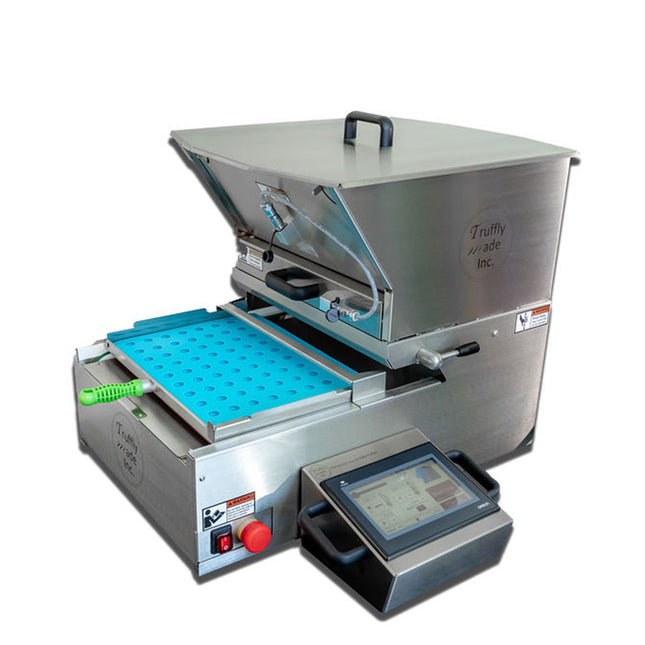

Truffly Made Truffly Made - Automatic Depositor 20L
Automatic Depositor 20L The Automatic Depositor comes with the 20 liters hopper with heated panels for chocolate, gummy, caramel and hard candy.10 depositing pistons for maximum efficiency and productivity; Stainless steel construction with adjustable depositing nozzles that can be easily positioned to each mold layout.Touchscreen Unit Control that allow you to set the required temperature and volume before and during live production.This depositor is designed to work with all the Truffly Made silicone molds and most polycarbonate molds, it delivers accurately metered fillings with great flexibility and can deposit 10,000+ pieces per hour. This system is designed to work with all Truffly Made silicone molds, as well non-Truffly Made molds (Programming fee applies), it delivers accurately metered fillings with great flexibility and can deposit 10,000+ pieces per hour. REMELTING PRODUCT SUCH AS “Albanese Gummies®” IS NOT COMPATIBLE WITH THIS SYSTEM DUE TO VISCOSITY BEING TOO HIGH. For a Professional and Certified remelting process please refer to: – LorAnn Oils Gummy Mix– Melt To Make™– Candy Pros Automatic Confectionery Depositor Truffly Made Automatic Universal Candy Depositor For Gummies, Caramel, Hard Candy: The Truffly Made, Candy Depositor For Gummies, Caramel, Hard Candy is designed to remove the burden of filling multiple cavity candy molds while increasing the accuracy and uniformity of filling each mold. It works with both low heat confectionery ingredients such as chocolate and ganache, as well as high heat candy ingredients such as caramel, gummies and hard candy. The Automatic Depositor has a large 20L hopper with heated panels Easily adjustable shot size control. Ten nozzles have adjustable centerlines to accommodate various mold configurations. The Automatic Depositor works with molds up to 11.5 inches wide and 15 inches long. Nozzles are removable to accommodate molds with less cavities. Heated panels help chocolate, caramel or gummy products maintain temperature to flow properly. Variable temperature control through Touchscreen Unit Control 40mm L nozzles Compact, space saving design CE certified Made in Germany. The Automatic Depositor ships with: 10 pistons assembly Complete Heating System 40mm L nozzles stainless steel 20L hopper with cover stainless steel balls stainless steel pallet carrier spare o-rings Width: 19.0” Length: 27.5” Height: 22.5” Weight: 143 lbs Dosage : 1.5 to 7 ml / 0.05 to 0.20 fl oz per pull Accuracy: 0.1 gram / 0.003 fl oz. Capacity : 5.3 gal / 20 liter Filling Capacity: 10,000+ hourly Power Input : 100-240V AC / 50-60Hz Power Output : 24V DC / max.600W Material: Stainless Steel Maximum Heat : 302°F / 150°C Guarantee: 12 Months from date of purchase. The complete Automatic Depositor can be disassembled without tools for cleaning purposes. Technical Specs
$52,331.13 - $55,107.32
-
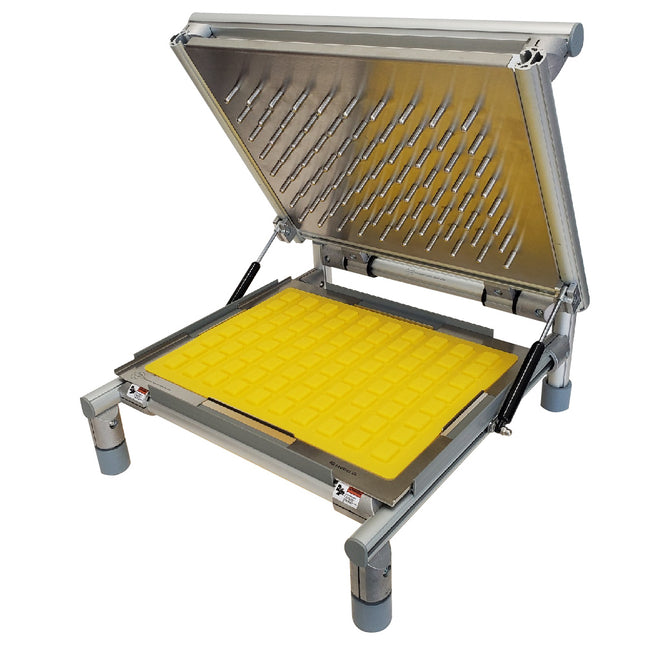

Truffly Made Truffly Made - Universal Candy Demolder
Universal Candy Demolder Universal Candy Demolder is designed to remove a full sheet of candies from molds in one “pop”. Demold your trays in second! Ideal for Hard Candies, Gummies, Caramels, Chocolate and Fruit Jelly! The mold “Popper” includes one standard mold frame to match the mold you are using. Please note that the mold is not included. Custom mold plates are available for additional 911 USD to work with your silicone molds. Dimensions: 19.75” w x 19.25” L x 8.25” H The Universal Demolder is compatible with most Truffly Made molds and Non-Truffly Made molds as long as the cavities can be popped inside-out completely and minimum 8mm spacing between each cavities. Maximum cavities per mold = 80 Maximum Mold size = 11.5 x 15” Please contact info@trufflymade.com for a custom quote LARGE PIN FITTINGS AVAILABLE HERE ☜ Please select the type of mold you are using from the list, All Truffly Made molds listed are compatible with the demolder. For any silicone mold not listed, or is from a different manufacturer, please contact us before placing an order to verify compatibility. The Truffly Made Universal Demolder. Easy to use, just one pull to pop out a full mold sheet of candies. Works best if the candies are cooled off and hardened! Select the mold frame that matches the mold you are using. Place the mold frame on to the Demolder. Add your filled mold on top of frame. Pull lever. DONE! All your candies are demolded. PLEASE NOTE THAT THE UNMOLDING EFFICIENCY IS VARIABLE DEPENDING ON PRODUCT STICKINESS. WE RECOMMAND TO UNMOLD WITHIN 3 HOURS AFTER DEPOSITNG FOR BETTER EFFICIENCY. SILICONE MOLDS CAN BE PRE-COATED USING MCT OIL , MINERAL OIL OR COOKING SPRAY TO INCREASE UNMOLDING EFFICIENCY.
$4,484.93 - $5,848.04
-
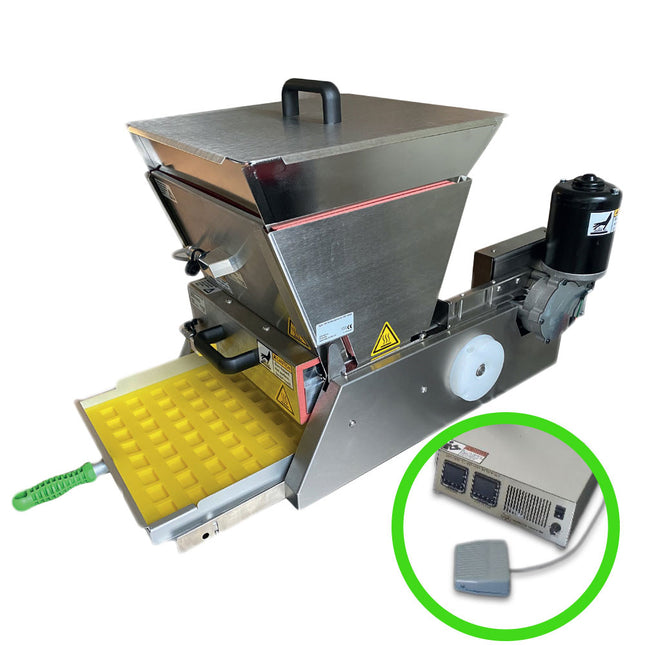

Truffly Made Truffly Made - Semi-Automatic Depositor - Push & Go
Semi-Automatic Depositor - Push & Go Ideal for novice and experienced operators! The 8 Pistons Semi-Automatic Candy Depositor for chocolate, gummies, taffy, caramel and hard candy is designed to work with all the Truffly Made silicone molds and most polycarbonate molds up to 11.5 inches wide, it delivers accurately metered fillings with great flexibility. Stainless steel construction with adjustable depositing nozzles that can be easily positioned to each mold layout. The Semi-automatic Depositor comes with a complete heating system with temperatures ranging from 68F to 320F. Filling Capacity: 5,000 – 8,000+ hourly Semi-Automatic 8 Pistons Tabletop Confectionery Depositor Truffly Made Semi-Automatic Candy Depositor For Gummies, Caramel, Hard Candy. The Truffly Made, Candy Depositor For Gummies, Caramel, Hard Candy is designed to remove the burden of filling multiple cavity candy molds while increasing the accuracy and uniformity of filling each mold. It works with both low heat confectionery ingredients such as chocolate and ganache, as well as high heat candy ingredients such as caramel, gummies and hard candy. The Universal Candy Depositor comes with the hopper with heated panels. This Confectionery Depositor has a large hopper with heated panels Easily adjustable shot size control. Eight nozzles have adjustable centerlines to accommodate various mold configurations. The Semi-Automatic Depositor works with molds up to 11.5 inches wide. Nozzles are removable to accommodate molds with less cavities. Heated panels help chocolate, caramel or gummy products maintain temperature to flow properly. Variable temperature control Heavy Duty nozzles Compact, space saving design CE certified Made in Germany. The Universal Semi-Automatic Candy Depositor ships with: 8 piston assemblies Complete Heating System Heavy Duty nozzles stainless steel hopper with cover stainless steel balls aluminum pallet carrier spare o-rings Specifications Width: 18.75” Length: 26.5” Height: 17.5” Weight: 88 lbs Dosage : 1.5 to 7 ml / 0.05 to 0.20 fl oz per pull Capacity : 3.2 gal / 12 liter Filling Capacity: 5,000 - 8,000+ hourly Power Input : 100-240V AC / 50-60Hz Power Output : 24V DC / max.600W Material: Stainless Steel Maximum Heat : 320°F / 160°C Warranty: 12 Months from date of purchase. The complete Universal Semi-Automatic Depositor can be disassembled without tools for cleaning.
$29,844.01
-
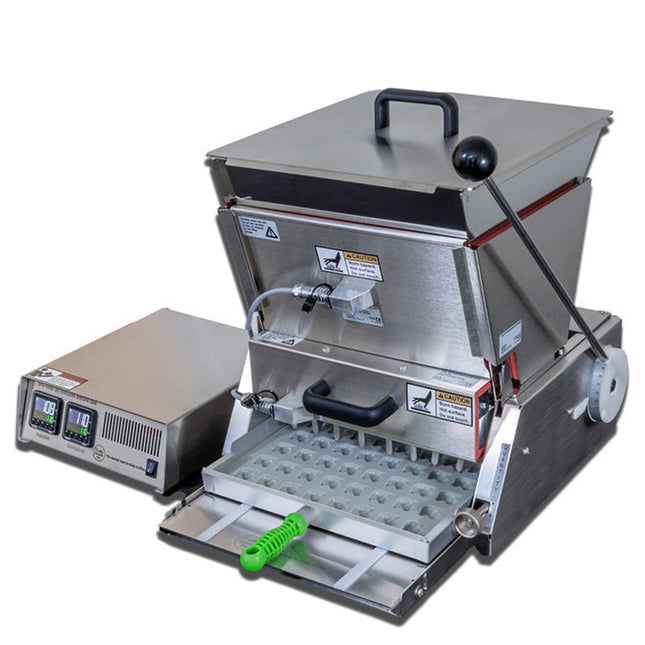

Truffly Made Truffly Made - Universal Depositor XL
Universal Depositor XL he XL Universal Candy Depositor comes with the extra large hopper with heated panels for gummies and hard candies is designed to work with all the Truffly Made silicone molds and most polycarbonate molds up to 11.5 inches wide, it delivers accurately metered fillings with great flexibility. Stainless steel construction with eight adjustable depositing nozzles that can be easily positioned to each mold layout. Comes with 8 Pistons setup with Heavy Duty Nozzles Tabletop XL Confectionery Depositor Truffly Made XL Universal Candy Depositor For Gummies, Caramel, Hard Candy. The Truffly Made, XL Candy Depositor For Gummies, Caramel, Hard Candy is designed to remove the burden of filling multiple cavity candy molds while increasing the accuracy and uniformity of filling each mold. It works with both low heat confectionery ingredients such as chocolate and ganache, as well as high heat candy ingredients such as caramel, gummies and hard candy. This Confectionery Depositor has a extra large 12 liter/3.2 gal hopper with heated panels Easily adjustable shot size control. Eight nozzles have adjustable centerlines to accommodate various mold configurations. The Universal Depositor works with molds up to 11.5 inches wide. Nozzles are removable to accommodate molds with less cavities. Heated panels help chocolate, caramel or gummy products maintain temperature to flow properly. Digital, variable temperature control Additional pistons and nozzles available Heavy Duty nozzles Compact, space saving design CE certified Made in Germany. The Universal Candy Depositor ships with: 8 piston assembly Complete Heating System Heavy Duty nozzles stainless steel XL hopper with cover stainless steel balls aluminum pallet carrier spare o-rings service pack Specifications Width: 15.75” Length: 20.5” Height: 17.5” Weight: 49 lbs Dosage : 1.5 to 7 ml / 0.05 to 0.20 fl oz per pull Capacity: 3.2 gal / 12 liter Filling Capacity: 5,000+ hourly Power Input : 100-240V AC / 50-60Hz Power Output : 24V DC / max.600W Material: Stainless Steel Maximum Heat : 320°F / 160°C Guarantee: 12 Months from date of purchase. The complete XL Universal Depositor can be disassembled without tools for cleaning.
$23,235.30
-
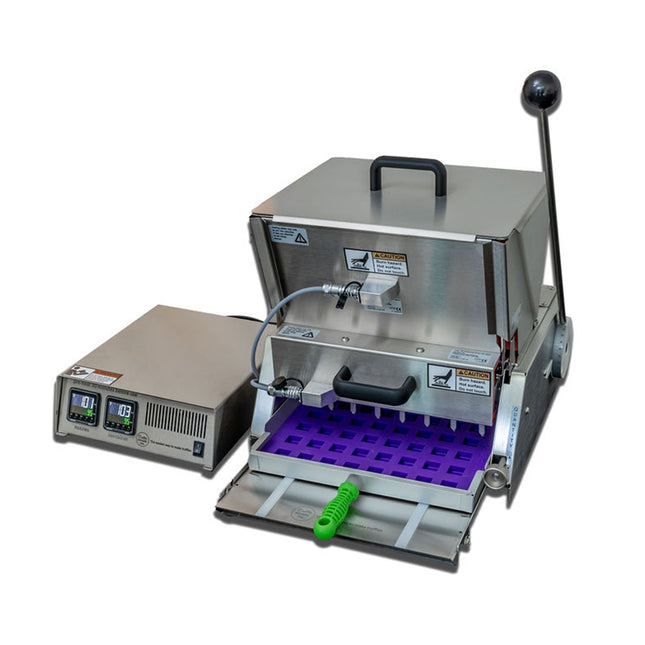

Truffly Made Truffly Made - Universal Depositor 6L
Universal Depositor 6L The Universal Candy Depositor for gummies and hard candies is designed to work with all the Truffly Made silicone molds and most polycarbonate molds up to 11.5 inches wide, it delivers accurately metered fillings with great flexibility. Stainless steel construction with adjustable depositing nozzles that can be easily positioned to each mold layout. The Universal Candy Depositor comes with the hopper with heated panels. Comes with 8 Pistons setup with Heavy Duty Nozzles Tabletop Confectionery Depositor The Truffly Made, Candy Depositor For Gummies, Caramel, Hard Candy is designed to remove the burden of filling multiple cavity candy molds while increasing the accuracy and uniformity of filling each mold. It works with both low heat confectionery ingredients such as chocolate and ganache, as well as high heat candy ingredients such as caramel, gummies and hard candy. The Universal Candy Depositor comes with the hopper with heated panels. This Confectionery Depositor has a large hopper with heated panels Easily adjustable shot size control. Eight nozzles have adjustable centerlines to accommodate various mold configurations. The Universal Depositor works with molds up to 11.5 inches wide. Nozzles are removable to accommodate molds with less cavities. Heated panels help chocolate, caramel or gummy products maintain temperature to flow properly. Digital, variable temperature control Additional pistons and nozzles available Heavy Duty nozzles Compact, space saving design CE certified Made in Germany. The Universal Candy Depositor ships with: 8 Pistons assembly Complete Heating System Heavy Duty nozzles stainless steel hopper with cover stainless steel balls aluminum pallet carrier spare o-rings Specifications Width: 15.75” Length: 20.5” Height: 14.5” Weight: 49 lbs Dosage : 1.5 to 7 ml / 0.05 to 0.20 fl oz per pull Capacity : 1.3 gal / 6 liter Filling Capacity: 2,000+ hourly Power Input : 100-240V AC / 50-60Hz Power Output : 24V DC / max.600W Material: Stainless Steel Maximum Heat : 320°F / 160°C Guarantee: 12 Months from date of purchase. The complete Universal Depositor can be disassembled without tools for cleaning. Instructions for Use
$18,737.88
-


Truffly Made Truffly Made - Gumdrop 80 Mold
Gumdrop 80 Mold Candy Mold Specifications: 3.0ml Gumdrop Mold – 80 CavitiesReference: TM-GD-080Mold Size : 292 x 381 mm (11.5” x 15”)Mold Layout: 10 x 8Cavities Per Mold: 80Cavity Size: 20 x 18 x 12 mm (0.78″ x 0.70″ x 0.47” )Cavity volume: 3.0 mL (0.10 fl oz)Approximate Weight: 3.5 – 4.0 grams (0.12 – 0.14 oz) Additional information 100% Platinum Cured Silicone Sheet Certified Food Grade and FDA Approved One mold sized to perfectly fill half of an 18 x 26 inch industrial sheet pan Bake or freeze with temperatures from -40°F up to 450°F. Flexible, durable and reliable. High grade silicone with strong resistance to warping, tearing or shrinking and flexible enough to allow for hassle free release of each candy. 12 month Warranty. Truffly Made silicone molds gives a precisely formed shaped candy. Can be used with chocolate, ganache, caramel, gummy, praline and hard candy. Eliminating the need for hand-manufacture and creates uniform candies every time. Truffly Made molds are the most advanced in professional confectionery products making and are the only molds that allows you to easily pop out candies in a one step process. These food grade non-stick silicone candy molds are simple to use, easy to clean, and saves on labor costs. They are designed for commercial use and are temperature resistant from -40°F. to 450°F to allow you to work with blast freezer and oven.
$106.81
-

BVV 3838 Nanofiltration Skid
BVV 3838 Nanofiltration Skid Note: This product carries 8 - 12 week lead time Perform organic solvent recovery or botanical extract purification with ease with our 3838 nanofiltration skid. Replace up to 22X 50L Rotary evaporators with a single Skid. BVV's 3838 Nanofiltration Skid is designed to meet Class 1 Division 1 standards. With the ability to recover 90 gallons of ethanol per hour without the application of heat, preserving target compounds and utilizing a fraction of the energy consumption of a traditional falling film qualifying our 3838 Nanofiltration Skid for energy saving rebates. Processing Power Capacity: 90 GPH of solvent recovery or purification. Solvents: Ethanol, Methanol Specifications 4X 3838 nanofiltration housings Stainless steel 26GPM pump with PTFE seals 15HP C1D1 1750 RPM Motor 15HP VFD 1/60/230 NEMA 4X enclosure (13A) Insulated 4"x24" Heat Exchanger 5 Ton low-temp glycol Chiller (230V/1P/60HZ/47.2A or 230V/3P/60HZ/35.1A available) 700PSI Pressure Relief Valve C1D1 Flowmeter 0-1000 PSI Pressure Gauges 1.5" Intake & Retentate Lines 1/2" Permeate & Pressure Relief Lines Footprint (DxWxH) 27"x60"x51" Weight: 885 lb Maximum Pressure Rating: 700PSI Performance Variable Frequency Drive-based flow control Complete pressure control with manual pressure controls Retentate cooling with inline Heat exchanger & chiller 700PSI pressure relief valve with diversion line *Components shown are subject to change**This unit is meant for bulk solvent recovery, 90% of the total volume of solvent an additional solvent recovery apparatus is recommended to evaporate to dryness*
$108,271.31
-
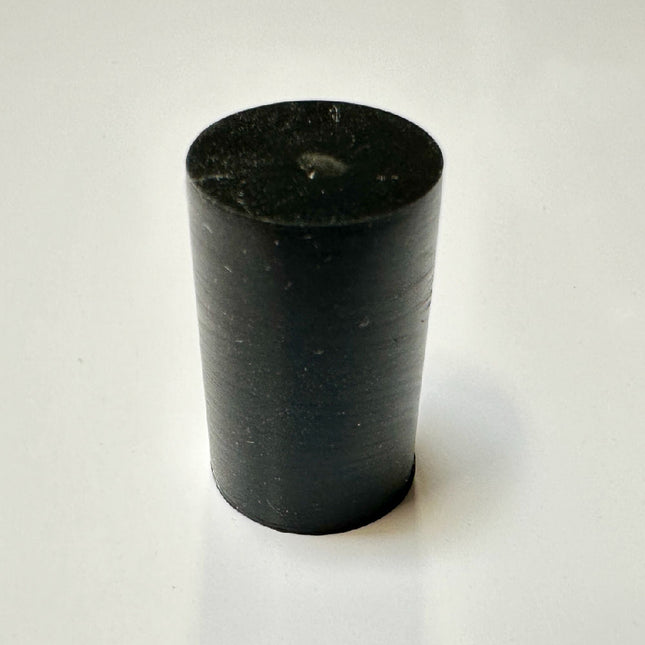

Truffly Made Truffly Made - Flat Pin Fittings for Universal Demolder - 80 Count
Flat Pin Fittings for Universal Demolder - 80 Count The pin fittings can be added on the original pins of the Universal Candy Demolder to increase the diameter and improve efficiency of unmolding with larger cavity size molds such as Button 80, Diamond 80, Rounded Triangle 80, or custom molds.Food contact safe and easy to clean using dish soap and hot water. Pins fittings are easy to add on and can be removed for cleaning purposes. Pack of 80 Pin Fittings Additional information 100% Platinum Cured Silicone Sheet Certified Food Grade and FDA Approved One mold sized to perfectly fill half of an 18 x 26 inch industrial sheet pan Bake or freeze with temperatures from -40°F up to 450°F. Flexible, durable and reliable. High grade silicone with strong resistance to warping, tearing or shrinking and flexible enough to allow for hassle free release of each candy. 12 month Warranty. Truffly Made silicone molds gives a precisely formed shaped candy. Can be used with chocolate, ganache, caramel, gummy, praline and hard candy. Eliminating the need for hand-manufacture and creates uniform candies every time. Truffly Made molds are the most advanced in professional confectionery products making and are the only molds that allows you to easily pop out candies in a one step process. These food grade non-stick silicone candy molds are simple to use, easy to clean, and saves on labor costs. They are designed for commercial use and are temperature resistant from -40°F. to 450°F to allow you to work with blast freezer and oven.
$460.83
-


Truffly Made Truffly Made - Drop 80 Mold
Drop 80 Mold Candy Mold Specifications: 1.85ml Drop Mold – 80 CavitiesReference: TM-DP-080Mold Size : 292 x 381 mm (11.5” x 15”)Mold Layout: 10 x 8Cavities Per Mold: 80Cavity Size: 12.5 x 14 mm Ø (0.49″ x 0.55” Ø)Cavity volume: 1.85 mL (0.06 fl oz)Approximate Weight: 2.0 – 2.5 grams (0.07 – 0.09 oz) Additional information 100% Platinum Cured Silicone Sheet Certified Food Grade and FDA Approved One mold sized to perfectly fill half of an 18 x 26 inch industrial sheet pan Bake or freeze with temperatures from -40°F up to 450°F. Flexible, durable and reliable. High grade silicone with strong resistance to warping, tearing or shrinking and flexible enough to allow for hassle free release of each candy. 12 month Warranty. Truffly Made silicone molds gives a precisely formed shaped candy. Can be used with chocolate, ganache, caramel, gummy, praline and hard candy. Eliminating the need for hand-manufacture and creates uniform candies every time. Truffly Made molds are the most advanced in professional confectionery products making and are the only molds that allows you to easily pop out candies in a one step process. These food grade non-stick silicone candy molds are simple to use, easy to clean, and saves on labor costs. They are designed for commercial use and are temperature resistant from -40°F. to 450°F to allow you to work with blast freezer and oven.
$106.81
-
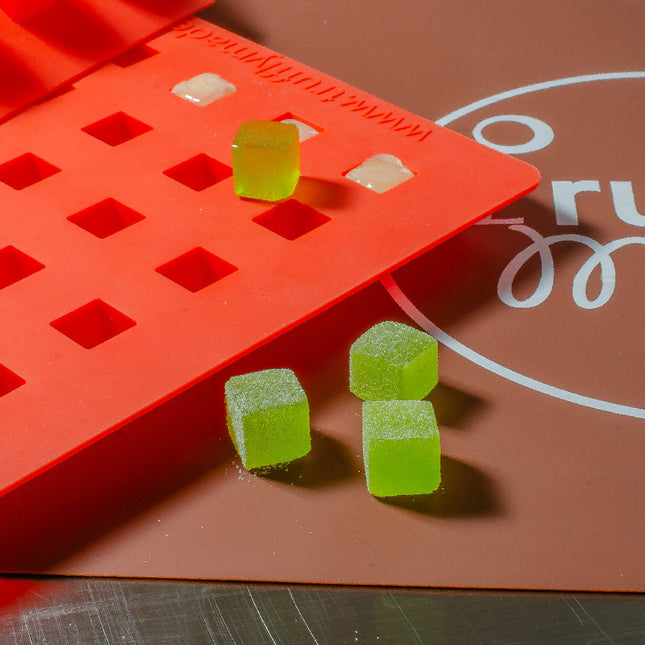

Truffly Made Truffly Made - Dice 80 Mold
Dice 80 Mold Candy Mold Specifications: Reference: TM-DC-080Mold Size : 292 x 381 mm (11.5” x 15”)Mold Layout: 8 x 10Cavities Per Mold: 80Cavity Size: 15 x 15 x 15 mm (19/32 x 10/32 x 19/32″)Cavity volume: 3.5 mL (0.12 fl oz)Approximate Weight: 4 – 4.5 grams (0.14 – 0.16 oz) Additional information 100% Platinum Cured Silicone Sheet Certified Food Grade and FDA Approved One mold sized to perfectly fill half of an 18 x 26 inch industrial sheet pan Bake or freeze with temperatures from -40°F up to 450°F. Flexible, durable and reliable. High grade silicone with strong resistance to warping, tearing or shrinking and flexible enough to allow for hassle free release of each candy. 12 month Warranty. Truffly Made silicone molds gives a precisely formed shaped candy. Can be used with chocolate, ganache, caramel, gummy, praline and hard candy. Eliminating the need for hand-manufacture and creates uniform candies every time. Truffly Made molds are the most advanced in professional confectionery products making and are the only molds that allows you to easily pop out candies in a one step process. These food grade non-stick silicone candy molds are simple to use, easy to clean, and saves on labor costs. They are designed for commercial use and are temperature resistant from -40°F. to 450°F to allow you to work with blast freezer and oven.
$106.81
-


Truffly Made Truffly Made - Diamond 80 Mold
Diamond 80 Mold Candy Mold Specifications: Reference: TM-DD-080Mold Size : 292 x 381 mm (11.5” x 15”)Mold Layout: 8 x 10Cavities Per Mold: 80Cavity Size: 10 x 15 x 20 mm (0.39″ x 0.59″ x 0.79″)Cavity volume: 2.0 mL (0.07 fl oz)Approximate Weight: 2.5 – 3 grams (0.08 – 0.11 oz) Additional information 100% Platinum Cured Silicone Sheet Certified Food Grade and FDA Approved One mold sized to perfectly fill half of an 18 x 26 inch industrial sheet pan Bake or freeze with temperatures from -40°F up to 450°F. Flexible, durable and reliable. High grade silicone with strong resistance to warping, tearing or shrinking and flexible enough to allow for hassle free release of each candy. 12 month Warranty. Truffly Made silicone molds gives a precisely formed shaped candy. Can be used with chocolate, ganache, caramel, gummy, praline and hard candy. Eliminating the need for hand-manufacture and creates uniform candies every time. Truffly Made molds are the most advanced in professional confectionery products making and are the only molds that allows you to easily pop out candies in a one step process. These food grade non-stick silicone candy molds are simple to use, easy to clean, and saves on labor costs. They are designed for commercial use and are temperature resistant from -40°F. to 450°F to allow you to work with blast freezer and oven.
$106.81
-
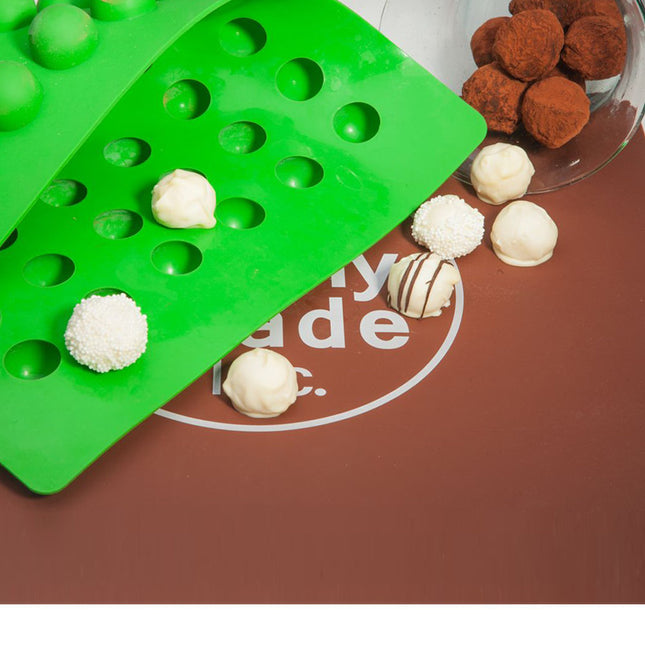

Truffly Made Truffly Made - Classic Round 80 Mold
Classic Round 80 Mold Reference: TM-RD-080Mold Size : 292 x 381 mm (11.5” x 15”)Mold Layout: 8 x 10Cavities Per Mold: 80Cavity Size: 27 dia x 22 mm (1.06 dia x 0.86”)Cavity volume: 11 mL (0.37 fl oz)Approximate Weight: 13 – 15 grams (0.45 – 0.53 oz) Additional information 100% Platinum Cured Silicone Sheet Certified Food Grade and FDA Approved One mold sized to perfectly fill half of an 18 x 26 inch industrial sheet pan Bake or freeze with temperatures from -40°F up to 450°F. Flexible, durable and reliable. High grade silicone with strong resistance to warping, tearing or shrinking and flexible enough to allow for hassle free release of each candy. 12 month Warranty. Truffly Made silicone molds gives a precisely formed shaped candy. Can be used with chocolate, ganache, caramel, gummy, praline and hard candy. Eliminating the need for hand-manufacture and creates uniform candies every time. Truffly Made molds are the most advanced in professional confectionery products making and are the only molds that allows you to easily pop out candies in a one step process. These food grade non-stick silicone candy molds are simple to use, easy to clean, and saves on labor costs. They are designed for commercial use and are temperature resistant from -40°F. to 450°F to allow you to work with blast freezer and oven.
$106.81
-


Truffly Made Truffly Made - Classic Cube 54 Mold
Classic Cube 54 Mold Candy Mold Specifications: 11ml Classic Cube – 54 CavitiesReference: TM-CC-020Mold Size : 292 x 381 mm (11.5” x 15”)Mold Layout: 9 x 6Cavities Per Mold: 54Cavity Size: 25 x 25 x 19 mm (1 x 1 x 3/4”)Cavity volume: 11 mL (0.37 fl oz)Approximate Weight: 13 – 15 grams (0.45 – 0.53 oz) Additional information 100% Platinum Cured Silicone Sheet Certified Food Grade and FDA Approved One mold sized to perfectly fill half of an 18 x 26 inch industrial sheet pan Bake or freeze with temperatures from -40°F up to 450°F. Flexible, durable and reliable. High grade silicone with strong resistance to warping, tearing or shrinking and flexible enough to allow for hassle free release of each candy. 12 month Warranty. Truffly Made silicone molds gives a precisely formed shaped candy. Can be used with chocolate, ganache, caramel, gummy, praline and hard candy. Eliminating the need for hand-manufacture and creates uniform candies every time. Truffly Made molds are the most advanced in professional confectionery products making and are the only molds that allows you to easily pop out candies in a one step process. These food grade non-stick silicone candy molds are simple to use, easy to clean, and saves on labor costs. They are designed for commercial use and are temperature resistant from -40°F. to 450°F to allow you to work with blast freezer and oven.
$106.81
-
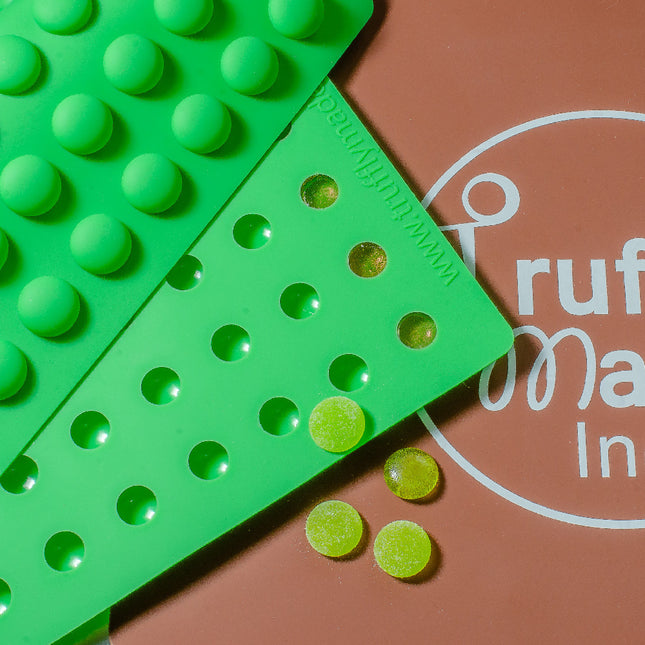

Truffly Made Truffly Made - Button 80 Mold
Button 80 Mold Candy Mold Specifications: Reference: TM-BN-080Mold Size : 292 x 381 mm (11.5” x 15”)Mold Layout: 8 x 10Cavities Per Mold: 80Cavity Size: 21.5mm Ø x 9.5mm (0.85 Ø x 0.37″)Cavity volume: 2.5 mL (0.085 fl oz)Approximate Weight: 3.0 – 3.5 grams (0.10 – 0.12 oz) Additional information 100% Platinum Cured Silicone Sheet Certified Food Grade and FDA Approved One mold sized to perfectly fill half of an 18 x 26 inch industrial sheet pan Bake or freeze with temperatures from -40°F up to 450°F. Flexible, durable and reliable. High grade silicone with strong resistance to warping, tearing or shrinking and flexible enough to allow for hassle free release of each candy. 12 month Warranty. Truffly Made silicone molds gives a precisely formed shaped candy. Can be used with chocolate, ganache, caramel, gummy, praline and hard candy. Eliminating the need for hand-manufacture and creates uniform candies every time. Truffly Made molds are the most advanced in professional confectionery products making and are the only molds that allows you to easily pop out candies in a one step process. These food grade non-stick silicone candy molds are simple to use, easy to clean, and saves on labor costs. They are designed for commercial use and are temperature resistant from -40°F. to 450°F to allow you to work with blast freezer and oven.
$106.81
-
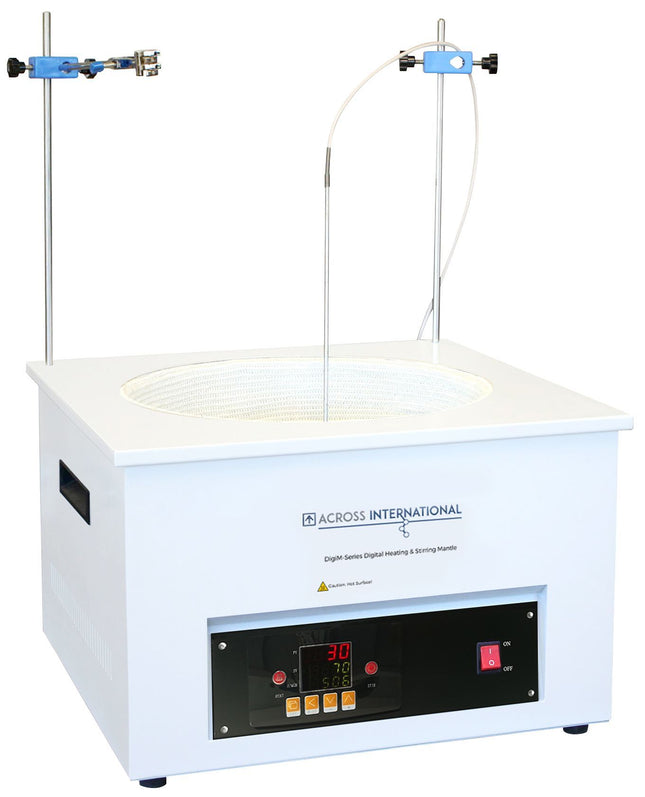

Across International Ai DigiM 20L 300C 1200 RPM Heating & Stirring Mantle - 220V
Ai DigiM 20L 300C 1200 RPM Heating & Stirring Mantle - 220V Across International heating and stirring mantles come standard with digital display for the most accurate control. The large display interface makes it easy to quickly and precisely adjust temperature and rotation speeds.The DigiM mantle is equipped with two sets of thermocouples for proper temperature and speed detection. The heating jacket is pre-treated before shipment, which ensures that no smoke or odors (caused by heat) are released into your work environment. Model DigiM20 Electrical requirements 220V 50/60Hz 1-Phase, 2900 watts, 13.2 A Heating Ambient to 300°C Stirring Min. speed: 110 rpm, max. speed: 1200 rpm Motor power: 40 watts Motor type: brushless DC motor Controller PID control with digital temperature and rotation speed display External thermocouple Type: PT100 Cable length: 43 inches Stainless steel probe length: 15 inches Stainless steel probe diameter: 5 mm Flask holder Maximum flask capacity: 20 liters Top opening diameter: 14.5 inches Depth: 7.5 inches Dimensions (WxDxH) Unit: 20.5 x 20.5 x 13 inches, shipping: 24 x 24 x 18 inches Weight Unit: 40 lbs, shipping: 50 lbs Safety Thermocouple failure protection Certification ETL tested to UL and CSA standards (optional), CE (standard) Warranty One year Standard package Part description Quantity Part image Ai DigiM 20L digital heating & stirring mantle 1 pc DigiM20: Cable Length: 43”, Probe Length: 15” 1 pc Internal temperature plug 1 pc Boss head DigiM20: 2 pcs 2 pcs Stainless steel support rod DigiM20: 2 pcs 2 pcs PTFE coated stir bar 2 pcs PTFE coated magnetic stir bar remover 1 pc 4 prong stainless steel clamp opens to 3 1/2" DigiM20: 2 pcs 2 pcs User's manual 1 pc
$2,207.07 - $2,970.52
-
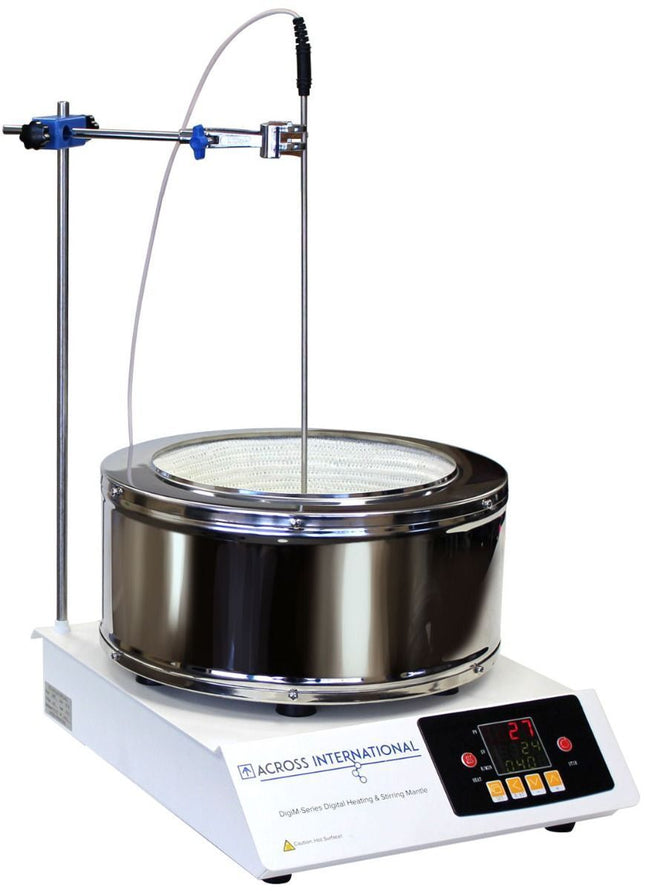

Across International Ai DigiM 5L 300C 1200 RPM PID Controlled Digital Heating Mantle
Ai DigiM 5L 300C 1200 RPM PID Controlled Digital Heating Mantle Across International heating and stirring mantles come standard with a digital display for the most accurate control. The large display interface makes it easy to quickly and precisely adjust temperature and rotation speeds.The DigiM mantle has two sets of thermocouples for proper temperature and speed detection. The heating jacket is pre-treated before shipment, which ensures that no smoke or odors (caused by heat) are released into your work environment. Specifications Model DigiM5 Electrical requirements 110V 60Hz 1-Phase, 1100 watts, 12A or 220V 50/60Hz 1-Phase, 1100 watts, 6A Heating Ambient to 300°C Stirring Min. speed: 110 rpm, max. speed: 1200 rpm Motor power: 40 watts Motor type: brushless DC motor Controller PID control with digital temperature and rotation speed display External thermocouple Type: PT100 Cable length: 43 inches Stainless steel probe length: 15 inches Stainless steel probe diameter: 5 mm Flask holder Maximum flask capacity: 5 liters Top opening diameter: 9 inches Depth: 5.5 inches Dimensions (WxDxH) Unit: 13.5 x 17 x 10 inches, shipping: 20 x 16 x 15 inches Weight Unit: 22 lbs, shipping: 32 lbs Safety Thermocouple failure protection Certification ETL tested to UL and CSA standards (optional), CE (standard) Warranty One year Standard package Part description Quantity Part image Ai DigiM 5L digital heating & stirring mantle 1 set External temperature probeDigiM05, DigiM2, DigiM5: Cable Length: 40”, Probe Length: 9” DigiM10, DigiM20: Cable Length: 43”, Probe Length: 15” 1 pc Internal temperature plug 1 pc Boss head DigiM2, DigiM5:- 1 pc DigiM10 and DigiM20: 2 pcs 1 or 2 pcs Stainless steel support rod DigiM2, DigiM5:- 1 pc DigiM10 and DigiM20: 2 pcs 1 or 2 pcs PTFE coated stir bar 2 pcs PTFE coated magnetic stir bar remover 1 pc 4 prong stainless steel clamp opens to 3 1/2" DigiM2, DigiM5:- 1 pc DigiM10, and DigiM20: 2 pcs 1 or 2 pcs User's manual 1 pc
$1,374.21 - $1,860.05
-
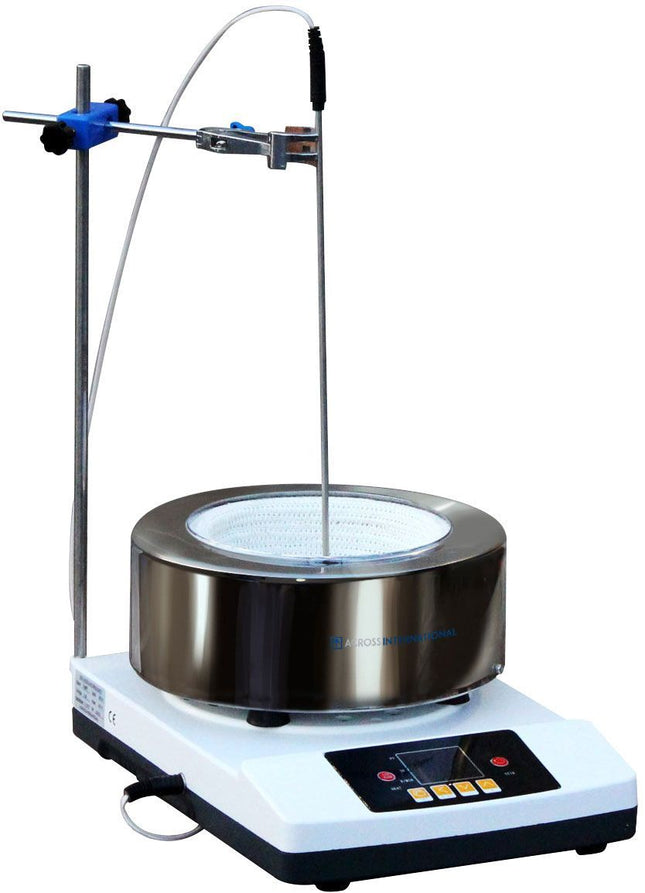
Across International Ai DigiM 2L 300C 1200 RPM PID Controlled Digital Heating Mantle
Ai DigiM 2L 300C 1200 RPM PID Controlled Digital Heating Mantle Across International heating and stirring mantles come standard with a digital display for the most accurate control. The large display interface makes it easy to quickly and precisely adjust temperature and rotation speeds. The DigiM mantle has two sets of thermocouples for proper temperature and speed detection. The heating jacket is pre-treated before shipment, which ensures that no smoke or odors (caused by heat) are released into your work environment. Model DigiM2 Electrical requirements 110V 60Hz 1-Phase, 700 watts, 8A or 220V 50/60Hz 1-Phase, 700 watts, 4A Heating Ambient to 300°C Stirring Min. speed: 110 rpm, max. speed: 1200 rpm Motor power: 40 watts Motor type: brushless DC motor Controller PID control with digital temperature and rotation speed display External thermocouple Type: PT100 Cable length: 40 inches Stainless steel probe length: 9 inches Stainless steel probe diameter: 5 mm Flask holder Maximum flask capacity: 2 liters Top opening diameter: 6.5 inches Depth: 4 inches Dimensions (WxDxH) Unit: 11 x 16 x 8.5 inches, shipping: 20 x 14 x 13 inches Weight Unit: 14 lbs, shipping: 25 lbs Safety Thermocouple failure protection Certification ETL tested to UL and CSA standards (optional), CE (standard) Warranty One year Standard package Part description Quantity Part image Ai DigiM 2L heating mantle 1 set External temperature probeDigiM05, DigiM2, DigiM5: Cable Length: 40", Probe Length: 9" DigiM10, DigiM20: Cable Length: 43", Probe Length: 15" 1 pc Internal temperature plug 1 pc Boss head DigiM2, DigiM5:- 1 pc DigiM10 and DigiM20: 2 pcs 1 or 2 pcs Stainless steel support rod DigiM2, DigiM5:- 1 pc DigiM10 and DigiM20: 2 pcs 1 or 2 pcs PTFE-coated stir bar 2 pcs PTFE-coated magnetic stir bar remover 1 pc 4 prong stainless steel clamp opens to 3 1/2" DigiM2, DigiM5:- 1 pc DigiM10 and DigiM20: 2 pcs 1 or 2 pcs User's manual 1 pc
$957.78 - $1,235.40
-
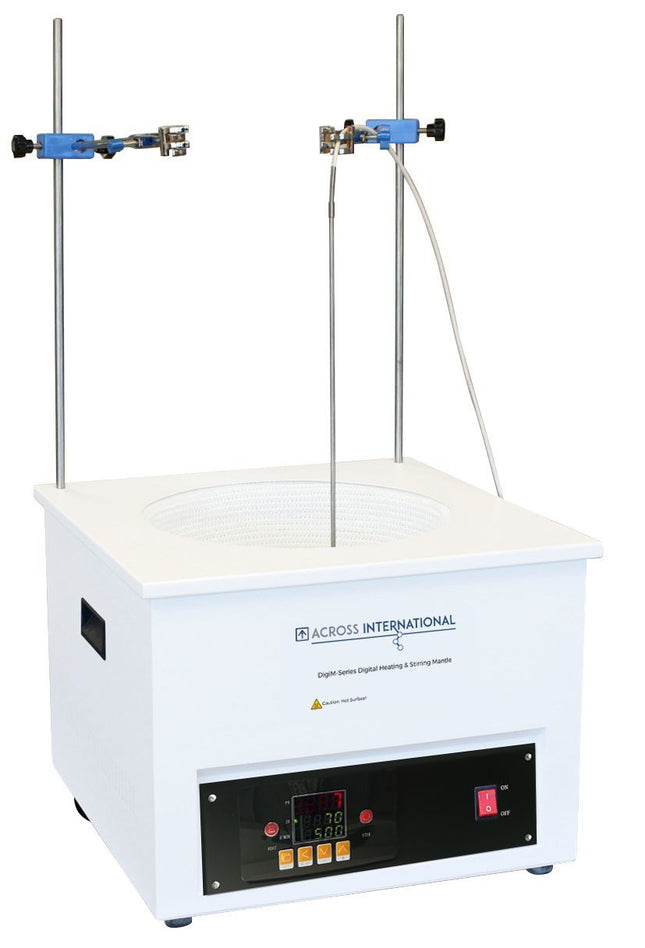

Across International Ai DigiM 10L 300C 1200 RPM Digital Heating & Stirring Mantle
Ai DigiM 10L 300C 1200 RPM Digital Heating & Stirring Mantle Across International heating and stirring mantles come standard with a digital display for the most accurate control. The large display interface makes it easy to quickly and precisely adjust temperature and rotation speeds.The DigiM mantle has two sets of thermocouples for proper temperature and speed detection. The heating jacket is pre-treated before shipment, which ensures that no smoke or odors (caused by heat) are released into your work environment. Model DigiM10 Electrical requirements 110V 60Hz 1-Phase, 2050 watts, 24A or 220V 50/60Hz 1-Phase, 2050 watts, 12A Heating Ambient to 300°C Stirring Min. speed: 110 rpm, max. speed: 1200 rpm Motor power: 40 watts Motor type: brushless DC motor Controller PID control with digital temperature and rotation speed display External thermocouple Type: PT100 Cable length: 43 inches Stainless steel probe length: 15 inches Stainless steel probe diameter: 5 mm Flask holder Maximum flask capacity: 10 liters Top opening diameter: 11.75 inches Depth: 6.5 inches Dimensions (WxDxH) Unit: 18 x 17.5 x 13 inches, shipping: 22 x 21 x 18 inches Weight Unit: 30 lbs, shipping: 40 lbs Safety Thermocouple failure protection Certification ETL tested to UL and CSA standards (optional), CE (standard) Warranty One year Standard package Part description Quantity Part image Ai DigiM 10L digital heating & stirring mantle 1 pc External temperature probeDigiM05, DigiM2, DigiM5: Cable Length: 40”, Probe Length: 9” DigiM10, DigiM20: Cable Length: 43”, Probe Length: 15” 1 pc Internal temperature plug 1 pc Boss head DigiM2, DigiM5:- 1 pc DigiM10 and DigiM20: 2 pcs 1 or 2 pcs Stainless steel support rod DigiM2, DigiM5:- 1 pc DigiM10 and DigiM20: 2 pcs 1 or 2 pcs PTFE-coated stir bar 2 pcs PTFE-coated magnetic stir bar remover 1 pc 4 prong stainless steel clamp opens to 3 1/2" DigiM2, DigiM5:- 1 pc DigiM10 and DigiM20: 2 pcs 1 or 2 pcs User's manual 1 pc
$1,651.83 - $2,762.31
-
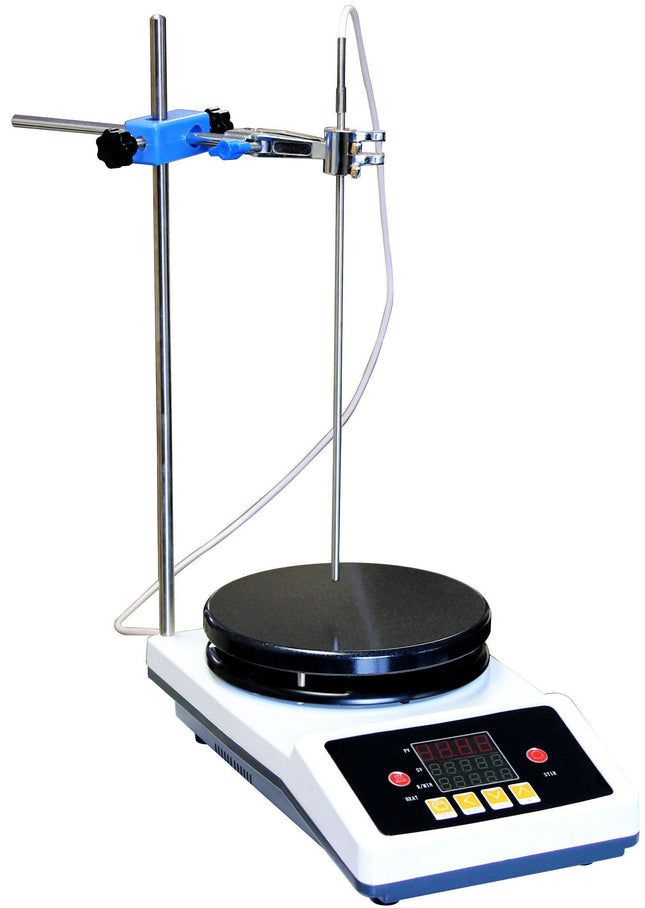

Across International 350C 2000RPM 1-Gallon PID Magnetic Stirrer With 7" Heated Plate
350C 2000RPM 1-Gallon PID Magnetic Stirrer With 7" Heated Plate A magnetic stirrer or magnetic mixer is a laboratory device that employs a rotating magnetic field to cause a stir bar (also called "flea") immersed in a liquid to spin quickly, thus stirring it. A rotating magnet or a set of stationary electromagnets placed beneath the vessel with the liquid may create a rotating field. Since glass does not affect a magnetic field appreciably (it is transparent to magnetism), and most chemical reactions take place in glass vessels (i.e., see beaker (glassware) or laboratory flasks), magnetic stir bars work well in glass vessels. On the other hand, the limited size of the bar means that magnetic stirrers can only be used for relatively small experiments. They also have difficulty dealing with viscous liquids or thick suspensions. Mechanical stirring is typically needed for larger volumes or more viscous fluids. Magnetic stirrers are often used in chemistry and biology. They are preferred over gear-driven motorized stirrers because they are quieter, more efficient, and have no moving external parts to break or wear out (other than the simple bar magnet itself). Because of its small size, a stirring bar is more easily cleaned and sterilized than other stirring devices. They do not require lubricants, which could contaminate the reaction vessel and the product. They can be used inside hermetically closed vessels or systems without complicated rotary seals. Magnetic stirrers may also include a hot plate or other liquid heating methods. Model HP7 Electrical requirements 110V 60Hz 1-Phase, 450 watts Temperature range Ambient to 350°C Heating plate Diameter: 7 inches Material: ceramic-coated aluminum Stirring Min. speed: 110 rpm, max. speed: 2000 rpm Motor power: 40 watts Motor type: brush-less DC motor Max. stirring volume: 1 gallon (3.8 liters, water as media) Controller PID control with digital temperature and rotation speed display External thermocouple Type: PT100 Cable length: 35 inches Stainless steel probe length: 11 inches Stainless steel probe diameter: 5 mm Dimensions (WxDxH) Unit: 7 x 12.5 x 4.5 inches, shipping: 10 x 16 x 9 inches Weight Unit: 10 lbs, shipping: 20 lbs Safety Thermocouple failure protection Built-in fuse protection Certification ETL tested to UL and CSA standards (optional), CE (standard) Warranty One year Standard package Part description Quantity Part image Ai HP7 digital heated magnetic stirrer 1 set External temperature probe Cable Length: 35”, Probe Length 11” 1 pc Internal temperature plug 1 pc Boss head 1 pc Stainless steel support rod (16 inches) 1 pc PTFE-coated stir bar 2 pcs PTFE-coated magnetic stir bar remover 1 pc 4 prong stainless steel clamp opens to 3 1/2" 1 pc User's manual 1 pc
$624.64 - $832.86
-
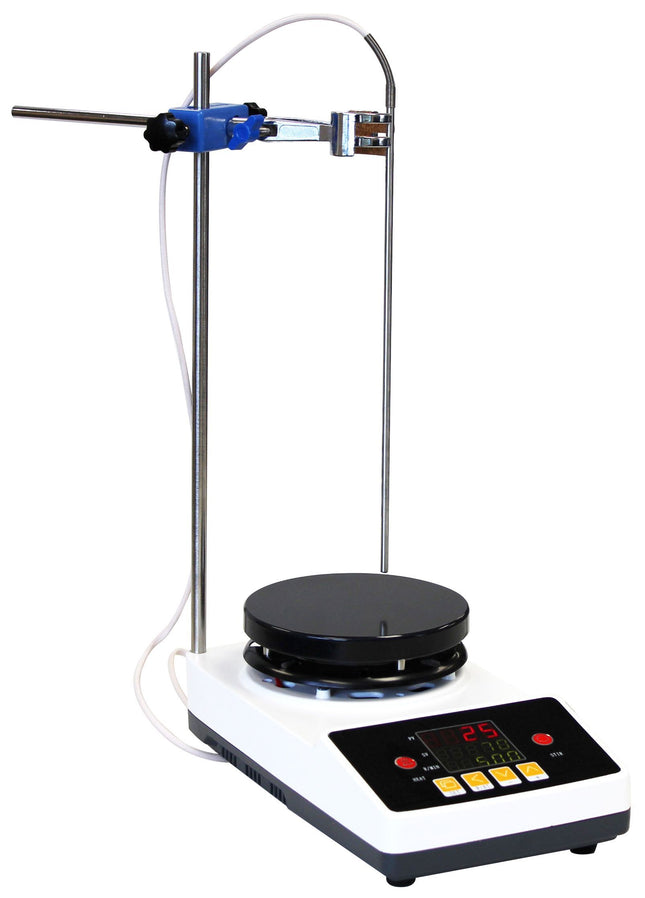

Across International 350C 2000RPM 0.8-Gallon PID Magnetic Stirrer 5.5" Heated Plate
350C 2000RPM 0.8-Gallon PID Magnetic Stirrer 5.5" Heated Plate A magnetic stirrer or magnetic mixer is a laboratory device that employs a rotating magnetic field to cause a stir bar (also called "flea") immersed in a liquid to spin quickly, thus stirring it. A rotating magnet or a set of stationary electromagnets placed beneath the vessel with the liquid may create a rotating field. Since glass does not affect a magnetic field appreciably (it is transparent to magnetism), and most chemical reactions take place in glass vessels (i.e., see beaker (glassware) or laboratory flasks), magnetic stir bars work well in glass vessels. On the other hand, the limited size of the bar means that magnetic stirrers can only be used for relatively small experiments. They also have difficulty dealing with viscous liquids or thick suspensions. Mechanical stirring is typically needed for larger volumes or more viscous fluids. Magnetic stirrers are often used in chemistry and biology. They are preferred over gear-driven motorized stirrers because they are quieter, more efficient, and have no moving external parts to break or wear out (other than the simple bar magnet itself). Because of its small size, a stirring bar is more easily cleaned and sterilized than other stirring devices. They do not require lubricants, which could contaminate the reaction vessel and the product. They can be used inside hermetically closed vessels or systems without complicated rotary seals. Magnetic stirrers may also include a hot plate or other liquid heating methods. Model HP5 Electrical requirements 110V 60Hz 1-Phase, 450 watts Temperature range Ambient to 350°C Heating plate Diameter: 5.5 inches Material: ceramic-coated aluminum Stirring Min. speed: 110 rpm, max. speed: 2000 rpm Motor power: 40 watts Motor type: brush-less DC motor Max. stirring volume: 0.8 gallons (3 liters, water as media) Controller PID control with digital temperature and rotation speed display External thermocouple Type: PT100 Cable length: 35 inches Stainless steel probe length: 11 inches Stainless steel probe diameter: 5 mm Dimensions (WxDxH) Unit: 6.5 x 12 x 4.25 inches, shipping: 16 x 9.5 x 7.5 inches Weight Unit: 9 lbs, shipping: 18 lbs Safety Thermocouple failure protection Built-in fuse protection Certification ETL tested to UL and CSA standards (optional), CE (standard) Warranty One year Standard package Part description Quantity Part image Ai HP5 digital heated magnetic stirrer 1 set External temperature probe Cable Length: 35", Probe Length 11" 1 pc Internal temperature plug 1 pc Boss head 1 pc Stainless steel support rod (16 inches) 1 pc PTFE coated stir bar 2 pcs PTFE-coated magnetic stir bar remover 1 pc 4 prong stainless steel clamp opens to 3 1/2" 1 pc User's manual 1 pc
$527.48 - $735.69
-
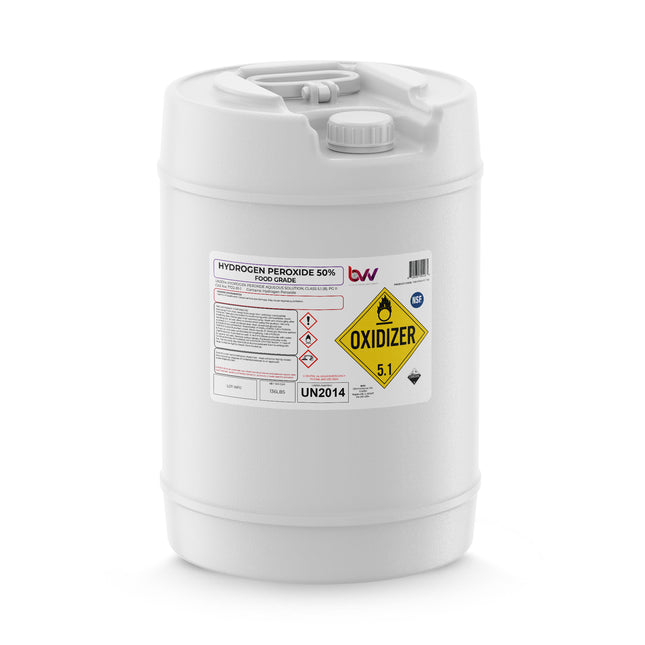

Hydrogen Peroxide 50% Food Grade
50% Food Grade Hydrogen Peroxide Our Food-grade 50% peroxide tests at ~50.4%. This the strongest peroxide we offer, next to our 35% Food Grade Peroxide, Our Food Grade 50% hydrogen peroxide is formulated with a special stabilizer package (organophosphonate) that replaces transition metals stabilizers typically found in hydrogen peroxide solutions. Our Peroxide is NSF® Certified. NSF-certified means a product was independently verified for safety, sanitation, and quality by NSF. NSF certification is recognized by health departments, government agencies, and industry associations. *Certified under ANSI/NSF Standard 60 Drinking Water Additives-Health Effects. Dosage levels shall be in accordance with NSF requirements. 55 Gallon Drum weights 548lbs, 270 Gallon Tote weighs 2500lbs. hydrogen peroxide usually loses less than 1% of its initial concentration in one year (0.5% for a 50% solution). 50% Hydrogen Peroxide NSF Food Grade Certificate of Analysis 50% Hydrogen Peroxide NSF Food Grade Safety Data Sheet Chemical Formula: H2O2 Molecular Weight: 34.015 g/mol CAS Registry Number: 7722-84-1 Appearance Colorless Liquid Odor: None Density 1.196 g/cm3 @ 20 °C (68 °F) Boiling Point: 114 °C (237 °F) Solubility in water: Completely Soluble GHS Pictograms: GHS Signal Word: Danger GHS Hazard Statements: H272, H302 + H332, H314, H335 GHS Precautionary Statements P210, P220, P260, P261, P264, P270, P271, P280, P283, P301+P317, P301+P330+P331, P302+P361+P354, P304+P340, P305+P354+P338, P306+P360, P316, P317, P321, P330, P363, P370+P378, P371+P380+P375, P405, P420, and P501 UN Identification Number: 2014 Proper Shipping Name: 50% Hydrogen Peroxide, Aqueous Solution Transport Hazard Class: 5.1, 8 Packing Group: II DOT Placard:
$360.90 - $895.32
-
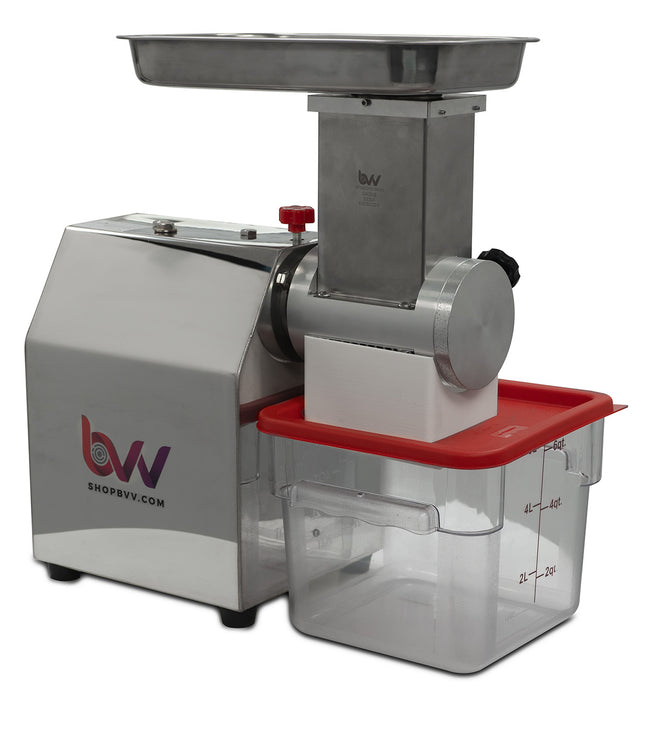

4" Industrial Plant Material Grinder (Compare to Custom Cones)
BVV 4" Industrial Plant Material Grinder The 4" grinder from BVV will grind your dried plant material into a consistent, manageable size. The grinder is easy to use and can power through over 1.5 lbs per minute or as fast as you can feed it! It can grind dense flower or leafy trim , as long as it is pre dried. This machine will help you keep the trichomes and terpenes in the plant where they should be due to the low operating temperature, in comparison to a common blender or food processor. This Grinder is made of food grade aluminum and stainless steel, and can be broken down for cleaning in a matter of seconds. Very few tools are needed to assemble and operate so you can keep your focus on moving material through this step in your production line. Included with the grinder are two stainless steel screens; 3.8mm small 6mm large Specifications Model Number G400 Voltage 115V / 60Hz Wattage 850w External Dimensions 16" x 9" x 20" Weight 42lbs
$2,984.40
-
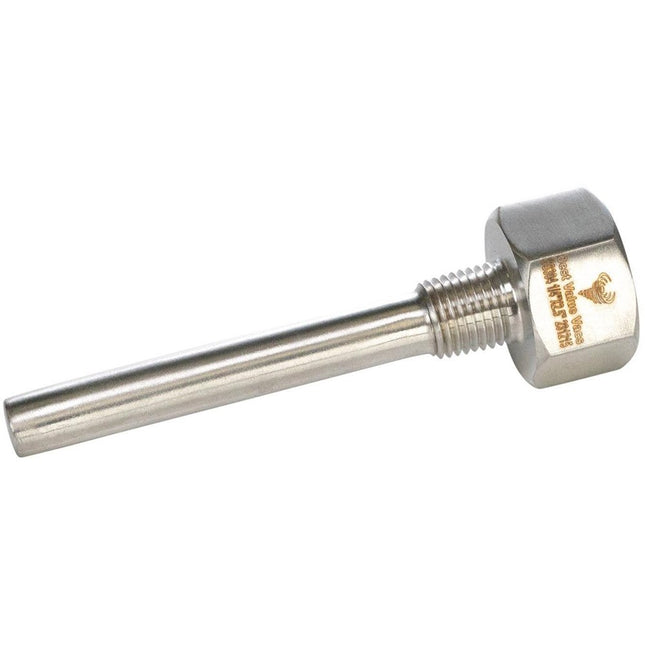

NPT Stainless Steel Thermowell
NPT Stainless Steel Thermowell These stainless steel thermowells are the perfect addition to an extraction system allowing the user to probe the internal temperate of a system component to know what temperature it is at. This thermowell feature 304 stainless steel and is 2.5" to 6" long with a 1/4" - 1/2" Male NPT threaded connect and a 1/4"-1/2" female NPT threaded connection on the top of the hex head.
$48.58 - $62.46
-
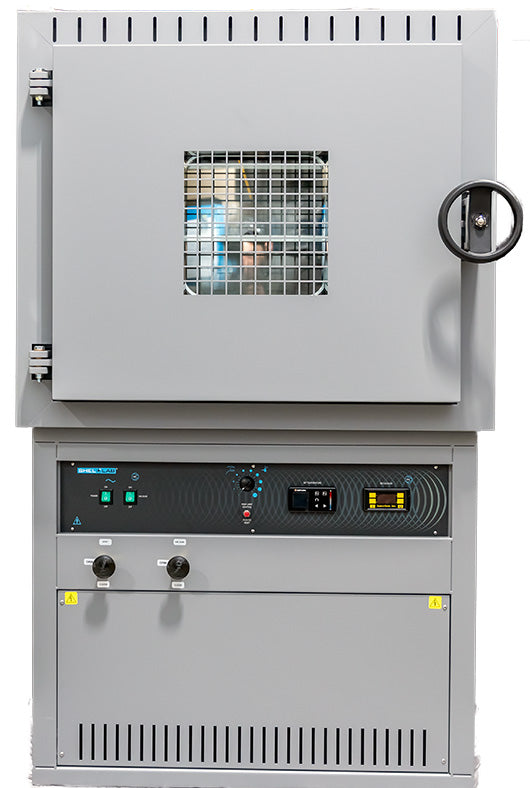

Sheldon Manufacturing Sheldon Manufacturing - VAC OVEN, 9.3 CUFT, 230V
Sheldon Manufacturing - VAC OVEN, 9.3 CUFT, 230V The SHEL LAB Model SVAC9-2 is one of the largest vacuum ovens on the market, with 9.3 cubic feet of capacity. This unit also features a fully programmable Watlow PM9 Plus controller and a cool touch surface. A digital vacuum gauge shows chamber vacuum level in measurements of Torr and m/Torr. The display range is 760 Torr down to 0 mTorr (Maximum permitted end vacuum is 10 mTorr. Leak rate is 30 mTorr in 30 min). A secondary independent high limit controller provides overtemperature safety protection. This unit includes true vacuum valves and has cross-flow ventilation within the oven chamber to enhance total performance. The vacuum oven is secured to a ruggedly constructed mobile stand to create a vacuum pump at the base. Although the oven is not supplied with a vacuum pump, all vacuum plumbing and KF25 connections are provided. The SHEL LAB SVAC9-2 vacuum oven is equipped with a Viton gasket, which provides an excellent combination of high-temperature performance and chemical resistance. When paired with this oven’s deep-draw capacity and large chamber volume, the SVAC9-2 serves as one of the most robust vacuum work stations available on the market. Features include: Watlow PM9 Plus Controller Capable Of 40 Step Ramp And Soak Profiles, Or 4 Files With 10 Steps Per File Stainless Steel Interior Stainless Steel Exterior Option Available (Ideal For Cleanroom Applications) KF25 Fitting Included Built in Vacuum Pump Mount 24 Month Limited Warranty
$32,511.93 $25,679.73
-
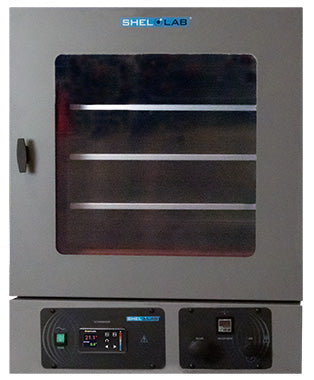

Sheldon Manufacturing Sheldon Manufacturing - VACUUM OVEN, 4.5 CUFT
Sheldon Manufacturing - VACUUM OVEN, 4.5 CUFT Our revamped SHEL LAB SVAC vacuum ovens provide exceptional capabilities for fast and gentle drying of heat-sensitive materials. Vacuum ovens prevent residue accumulation on products and use lower temperatures than typical convection ovens. Your products are processed with minimal impact and maximum throughput. SHEL LAB vacuum ovens have stainless steel interiors and provide exceptional durability and stability. Available in 4 sizes, SVAC Vacuum Ovens support a diverse array of applications. To achieve required vacuum levels, users can choose from a 3/8-inch orifice or a KF-25 fitting to withstand heavy use and minimize draw-down time. The doors on these units have positive latch handles with spring-loaded glass to facilitate a good vacuum seal without hinge binds that shorten the gasket life. The tempered glass viewing window allows for safe, continuous monitoring of samples. SHEL LAB Vacuum Ovens are equipped with silicone gaskets. Features include: Watlow PM9 Plus Controller Generous Usable Shelf Area Achieve Impressive Vacuum Levels Sizes Range from 0.6 – 4.5 Cubic Feet Built-in Overtemperature Protection 24 Month Limited Warranty Extended Warranties Available* (Ask Your SHEL LAB Sales Rep) Please note that this vacuum oven does not include a pump or related accessories. Contact your SHEL LAB distributor for assistance with choosing the ideal pump and accessories for any application.
$17,698.19 - $19,398.61
-
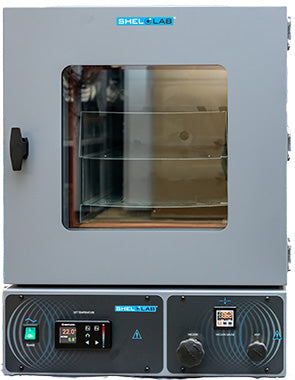

Sheldon Manufacturing Sheldon Manufacturing - VACUUM OVEN, 1.67 CUBIC FEET
Sheldon Manufacturing - VACUUM OVEN, 1.67 CUBIC FEET Our revamped SHEL LAB SVAC vacuum ovens provide exceptional capabilities for fast and gentle drying of heat-sensitive materials. Vacuum ovens prevent residue accumulation on products and use lower temperatures than typical convection ovens. Your products are processed with minimal impact and maximum throughput. SHEL LAB vacuum ovens have stainless steel interiors and provide exceptional durability and stability. Available in 4 sizes, SVAC Vacuum Ovens support a diverse array of applications.To achieve required vacuum levels, users can choose from a 3/8-inch orifice or a KF-25 fitting to withstand heavy use and minimize draw-down time. The doors on these units have positive latch handles with spring-loaded glass to facilitate a good vacuum seal without hinge binds that shorten the gasket life. The tempered glass viewing window allows for safe, continuous monitoring of samples. SHEL LAB Vacuum Ovens are equipped with silicone gaskets. Features include: Watlow PM9 Plus Controller Generous Usable Shelf Area Achieve Impressive Vacuum Levels Sizes Range from 0.6 – 4.5 Cubic Feet Built-in Overtemperature Protection 24 Month Limited Warranty Extended Warranties Available (Ask Your SHEL LAB Sales Rep) Please note that this vacuum oven does not include a pump or related accessories. Contact your SHEL LAB distributor for assistance with choosing the ideal pump and accessories for any application.
$9,022.61 - $9,924.87
-
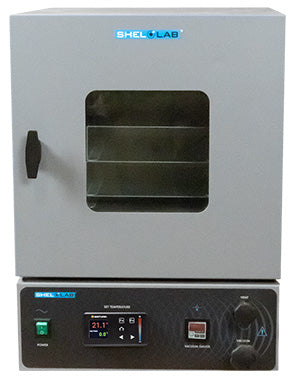

Sheldon Manufacturing Sheldon Manufacturing - VACUUM OVEN, 0.6 CUBIC FEET
Sheldon Manufacturing - VACUUM OVEN, 0.6 CUBIC FEET Our revamped SHEL LAB SVAC vacuum ovens provide exceptional capabilities for fast and gentle drying of heat-sensitive materials. Vacuum ovens prevent residue accumulation on products and use lower temperatures than typical convection ovens. Your products are processed with minimal impact and maximum throughput. SHEL LAB vacuum ovens have stainless steel interiors and provide exceptional durability and stability. Available in 4 sizes, SVAC Vacuum Ovens support a diverse array of applications. To achieve required vacuum levels, users can choose from a 3/8-inch orifice or a KF-25 fitting to withstand heavy use and minimize draw-down time. The doors on these units have positive latch handles with spring-loaded glass to facilitate a good vacuum seal without hinge binds that shorten the gasket life. The tempered glass viewing window allows for safe, continuous monitoring of samples. SHEL LAB Vacuum Ovens are equipped with silicone gaskets. Features include: Watlow PM9 Plus Controller Generous Usable Shelf Area Achieve Impressive Vacuum Levels Sizes Range from 0.6 – 4.5 Cubic Feet Built-in Overtemperature Protection 24 Month Limited Warranty Extended Warranties Available (Ask Your SHEL LAB Sales Rep) Please note that this vacuum oven does not include a pump or related accessories. Contact your SHEL LAB distributor for assistance with choosing the ideal pump and accessories for any application.
$7,218.09 - $7,842.73
-
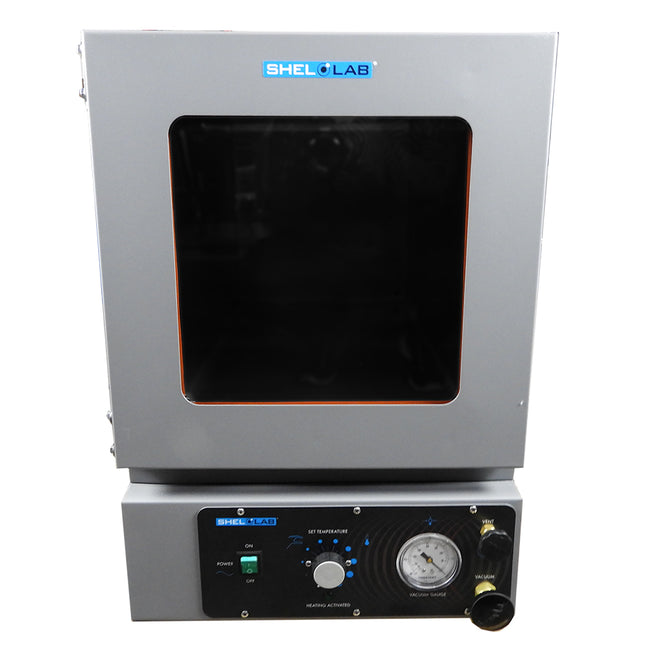

Sheldon Manufacturing Sheldon Manufacturing - ECONOMY VACUUM OVEN, 1.7 CUFT, NON CE
Sheldon Manufacturing - ECONOMY VACUUM OVEN, 1.7 CUFT, NON CE SHEL LAB vacuum ovens provide exceptional capabilities for fast and gentle drying of heat-sensitive materials. They prevent residue accumulation on products and allow safe drying of materials at lower temperatures than typically required when using convection ovens. These units feature a radiant heating system that optimizes chamber space and provides excellent heat transfer and temperature uniformity. All SHEL LAB vacuum ovens are built with stainless steel chambers that are easy to clean and have exceptional durability. The doors on these units have positive latch handles with spring-loaded glass to facilitate a good vacuum seal without hinge binds that shorten the gasket life. The tempered glass viewing window allows for safe, continuous monitoring of samples. A selection of gaskets (for specific applications) and a small benchtop footprint increase the versatility of these ovens. The SHEL LAB economy series of vacuum ovens are outstanding in any application. Features include: Analog Temperature Control Stainless-Steel Interior Built-in Overtemperature Protection 24 Month Limited Warranty
$3,678.45 - $4,025.47
You have seen 96 out of 1657 products


















































































